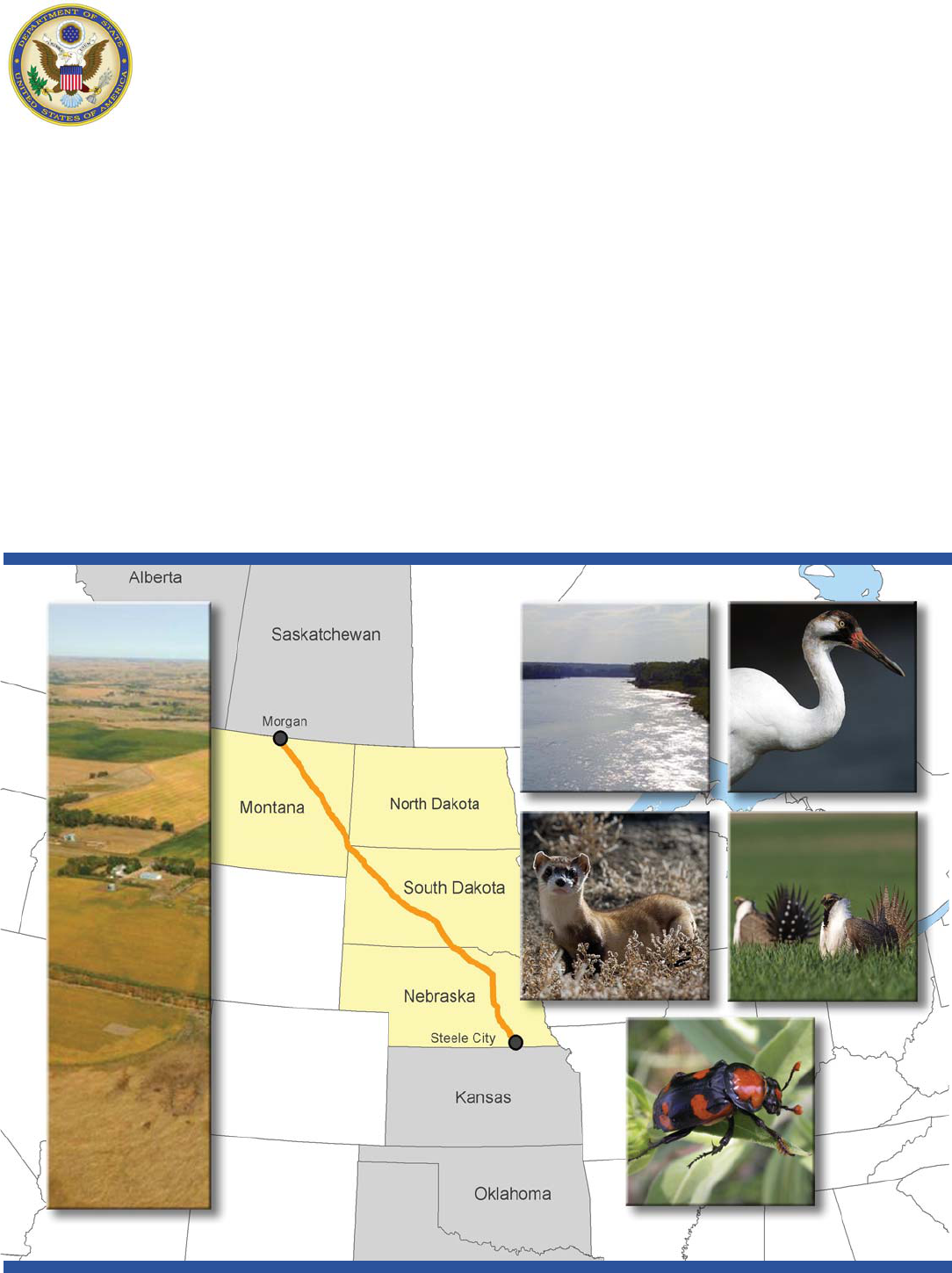
United States Department of State
Bureau of Oceans and International
Environmental and Scientic Aairs
Final Supplemental Environmental Impact Statement
for the
Keystone XL Project
Executive Summary
January 2014
Applicant for Presidential Permit: TransCanada Keystone Pipeline, LP

Front cover photo sources in order of appearance top to bottom:
Whooping crane
Hagerty, Ryan. 2012. Endangered Whooping Crane (Grus Americana). Photograph. U.S. Fish and Wildlife Service.
23 February 2012. Website: http://www.flickr.com/photos/usfwshq/6777481034/
.
Black-footed ferret
U.S. Fish & Wildlife Service. 2012. Black-footed ferret. Photograph. USFWS Headquarters. 3 July 2012. Website:
http://www.flickr.com/photos/usfwshq/7013874797/in/photolist-9Z7MXd-bFMWBP-bsoAvk-9DoXKC-bZh2uu/
.
Sage grouse
Rush, Kenneth. No Date. Male Greater Sage Grouse Strutting at Hat Six Lek near Casper, Wyoming. Photograph.
Shutterstock, Image ID: 52631191. Website:
http://www.shutterstock.com/pic-52631191/stock-photo-male-greater-
sage-grouse-strutting-at-hat-six-lek-near-casper-wyoming.html.
American burying beetle
Backlund, Doug. No date. Untitled [American Burying Beetle]. Photograph. U.S Fish & Wildlife Service – South
Dakota Field Office. Website: http://www.fws.gov/southdakotafieldoffice/BEETLE.HTM
.

United States Department of State
Final Supplemental Environmental Impact Statement
For the
KEYSTONE XL PROJECT
Applicant for Presidential Permit:
TransCanada Keystone Pipeline, LP
Executive Summary
Genevieve Walker
Project Manager
United States Department of State
Bureau of Oceans and International Environmental
and Scientific Affairs
2201 C Street NW, Room 2726
Washington, DC 20520
Cooperating Agencies
U.S. Army Corps of Engineers (USACE)
U.S. Department of Agriculture—Farm Service Agency (FSA)
U.S. Department of Agriculture—Natural Resource Conservation Service (NRCS)
U.S. Department of Agriculture—Rural Utilities Service (RUS)
U.S. Department of Energy (DOE)
U.S. Department of Interior—Bureau of Land Management (BLM)
U.S. Department of Interior—National Park Service (NPS)
U.S. Department of Interior—U.S. Fish and Wildlife Service (USFWS)
U.S. Department of Transportation—Pipeline and Hazardous Materials Safety Administration,
Office of Pipeline Safety (PHMSA)
U.S. Environmental Protection Agency (USEPA)
Assisting Agencies
U.S. Department of the Interior, Bureau of Reclamation (BOR)
Nebraska Department of Environmental Quality (NDEQ)
Various State and Local Agencies in Montana, South Dakota, Nebraska, and Kansas
January 2014

Volume I
1.0 Introduction
2.0 Description of the Proposed Project and Alternatives
Volume II
3.0 Affected Environment
Volume III
4.0 Environmental Consequences
Volume IV
5.0 Alternatives
6.0 List of Preparers
7.0 Distribution List—Final Supplemental EIS or Executive Summary
8.0 Index
Volume V
Comments and Responses (Part 1)
Volume VI
Comments and Responses (Part 2)
Volume VII
Appendix A Governor Approval of the Keystone XL Project in Nebraska
Appendix B Potential Releases and Pipeline Safety
Appendix C Supplemental Information to Market Analysis
Appendix D Waterbody Crossing Tables and Required Crossing Criteria for Reclamation Facilities
Appendix E Amended Programmatic Agreement and Record of Consultation
Appendix F Scoping Summary Report
Appendix G Construction, Mitigation, and Reclamation Plan
Volume VIII
Appendix H 2012 Biological Assessment, 2013 USFWS Biological Opinion, and Associated Documents
Volume IX
Appendix I Spill Prevention, Control, and Countermeasure Plan; and Emergency Response Plan
Appendix J Basin Electric Big Bend to Witten 230-kV Transmission Project Routing Report
Appendix K Historical Pipeline Incident Analysis
Appendix L Oil and Gas Wells within 1,320 ft of Proposed Right-of-Way
Appendix M Soil Summary for Montana, South Dakota, and Nebraska
Volume X
Appendix N Supplemental Information for Compliance with MEPA
Appendix O Socioeconomics
Appendix P Risk Assessment
Volume XI
Appendix Q Crude Oil Material Safety Data Sheets
Appendix R Construction/Reclamation Plans and Documentation
Appendix S Pipeline Temperature Effects Study
Appendix T Screening Level Oil Spill Modeling
Appendix U Lifecycle Greenhouse Gas Emissions of Petroleum Products from WCSB Oil Sands Crudes
Compared with Reference Crudes
Appendix V Literature Review
Appendix W Past, Present, and Reasonably Foreseeable Future Project Descriptions
Appendix X Canadian Environmental Assessment Act and Canadian Regulatory Review of Keystone XL
Appendix Y Estimated Criteria Pollutants, Noise, and GHG Emissions
Appendix Z Compiled Mitigation Measures

Final Supplemental Environmental Impact Statement Executive Summary
Keystone XL Project Table of Contents
.....................................................................................................................
........................................................................................................................
................................................................................................................................................
.........................................................
............................................................................................................
...................................................................................................................
..........................................................................................................
.....................................................................................................................
................................................................................................................
....................................................................................................................
....................................................................................
.......................................................................................................................................
....................................................................................................................................
.......................................................................................................................................
..............................................................................................................................
......................................................................................................................................
..................................................................................................................................................
.......................................................................................................
....................................................................................................................................
..............................................................................................................................
....................................................................................................................................................
...................................................................................................................................................
..................................................................................................................................................
..............................................................................................................................
...................................................................................................................................
..................................................................................................................................
...........................................................................................................
..............................................................................................................................................
..............................................................................................................................
...........................................................................................................
.................................................................................................................
.....................................................................................................................
................................................................................................
.....................................................................................................................
ES-i
TABLE OF CONTENTS
ES.1.0 Overview of Review Process 1
ES.1.1
Presidential Permit Process 1
ES.1.2
Background 1
ES.1.3
Public Comments Received Regarding the Draft Supplemental EIS 6
ES.1.4
About the Final Supplemental EIS 6
ES.2.0
Overview of Proposed Project 6
ES.2.1
Proposed Project Purpose and Need 6
ES.2.2
Proposed Project Description 7
ES.3.0
Overview of Petroleum Markets 9
ES.3.1
Summary of Market Analysis 9
ES.4.0
Environmental Analysis of the Proposed Project 14
ES.4.1
Climate Change 14
ES.4.2
Potential Releases 17
ES.4.3
Socioeconomics 19
ES.4.4
Environmental Justice 20
ES.4.5
Water Resources 21
ES.4.6
Wetlands 22
ES.4.7
Threatened and Endangered Species 23
ES.4.8
Geology and Soils 24
ES.4.9
Terrestrial Vegetation 24
ES.4.10
Wildlife 24
ES.4.11
Fisheries 25
ES.4.12
Land Use 25
ES.4.13
Air Quality and Noise 25
ES.4.14
Cultural Resources 25
ES.4.15
Cumulative Effects 26
ES.4.16
Environmental Impacts in Canada 27
ES.5.0
Alternatives 28
ES.5.1
No Action Alternative 28
ES.5.2
Major Pipeline Route Alternatives 29
ES.5.3
Other Alternatives Considered 32
ES.5.4
Comparison of Alternatives 32
ES.6.0
Guide to Reading the Supplemental EIS . 37
ES.7.0
Supplemental EIS Contents 37

Final Supplemental Environmental Impact Statement Executive Summary
Keystone XL Project Table of Contents
.........................................
..............................................................................
.......................................................................................
.............................................................................
..................................................................................................
............................................................................................................................
..............................................................................................................................
...............................................................................................
..................................................................................................................
...............................................................
...................................................................
...............................................................................................................
..........................................................
...
.............................................................................................
....................................................................................................................
............................................
.........................................................
................................................................................................................
..................................................................................................................
............................................................................
.........................................................................................
LIST OF TABLES
ES-ii
Table ES-1 Summary of PHMSA Database Incidents (January 2002 to July 2012) 18
Table ES-2
Spill Scenarios Evaluated in Supplemental EIS 18
Table ES-3
Effects of Potential Releases on Aquifers 23
Table ES-4
Summary of Major Pipeline Route Alternatives 30
Table ES-5
Physical Disturbance Impacts Associated with New Construction and Operations for the
Proposed Project and Alternatives 33
Table ES-6
Annual Greenhouse Gas Emissions from Crude Transport (from Hardisty/Lloydminster,
Alberta, to the Gulf Coast Area) Associated with the Proposed Project and Alternatives
(per 100,000 bpd) 34
Table ES-7
Potential Releases Impacts (Full Pathway) Associated with the Proposed Project
and Alternatives 36
LIST OF FIGURES
Figure ES-1 Proposed Keystone XL Project Route 2
Figure ES-2
Gulf Coast Project Route 4
Figure ES-3
Comparison of Proposed Project to 2011 Final EIS Route 5
Figure ES-4
Keystone XL, Typical Pipeline Construction Sequence 7
Figure ES-5
Proposed Project Overview 8
Figure ES-6
Estimated Crude Oil Transported by Rail from WCSB, bpd 10
Figure ES-7
Crude by Train Loading and Off-Loading Facilities in 2010 (top map) and 2013 (bottom map) 11
Figure ES-8
Oil Sands Supply Costs (West Texas Intermediate-Equivalent Dollars per Barrel), Project
Capacity, and Production Projections 13
Figure ES-9
The Greenhouse Effect 14
Figure ES-10
Incremental Well-to-Wheels GHG Emissions from WCSB Oil Sands Crudes Compared to
Well-to-Wheels GHG Emissions from Displacing Reference Crudes 16
Figure ES-11
Cross Section of the Horizontal Directional Drilling Method 22
Figure ES-12
American Burying Beetle 24
Figure ES-13
Indian Tribes Consulted 27
Figure ES-14
Representative No Action Alternative Scenarios 29
Figure ES-15
Preliminary Pipeline Route Alternatives 31

Final Supplemental Environmental Impact Statement Executive Summary
Keystone XL Project
ES-1
ES.1.0 OVERVIEW OF REVIEW
PROCESS
The Keystone XL Pipeline (the proposed Project) is a
proposed 875-mile pipeline project that would extend
from Morgan, Montana, to Steele City, Nebraska. The
pipeline would allow delivery of up to 830,000 barrels
per day (bpd) of crude oil from the Western Canadian
Sedimentary Basin (WCSB) in Canada and the Bakken
Shale Formation in the United States to Steele City,
Nebraska, for onward delivery to refineries in the Gulf
Coast area (see Figure ES-1). TransCanada Keystone
Pipeline, LP (Keystone) has applied for a Presidential
Permit that, if granted, would authorize the proposed
pipeline to cross the United States-Canadian border at
Morgan, Montana.
The proposed route differs from the route analyzed in
the 2011 Final Environmental Impact Statement
(2011 Final EIS) in that it would avoid the
environmentally sensitive Nebraska Department of
Environmental Quality (NDEQ)-identified Sand Hills
Region and no longer includes a southern segment from
Cushing, Oklahoma, to the Gulf Coast area.
The U.S. Department of State (the Department)
prepared this Final Supplemental Environmental Impact
Statement (the Supplemental EIS) to assess the
potential impacts associated with the proposed Project
and its alternatives. The Supplemental EIS takes into
consideration over 400,000 comments received during
the scoping period and 1.5 million comments received
on the Draft Supplemental EIS issued in March 2013.
Notable changes since the Draft Supplemental EIS
include:
• Expanded analysis of potential oil releases;
• Expanded climate change analysis;
• Updated oil market analysis incorporating new
economic modeling; and
• Expanded analysis of rail transport as part of the
No Action Alternative scenarios.
ES.1.1 Presidential Permit Process
For proposed petroleum pipelines that cross
international borders of the United States, the President,
through Executive Order (EO) 13337, directs the
Secretary of State to decide whether a project serves the
national interest before granting a Presidential Permit.
To make this decision (i.e., the National Interest
Determination), the Secretary of State, through the
Department, considers many factors, including energy
security; environmental, cultural, and economic
impacts; foreign policy; and compliance with relevant
state and federal regulations. This Supplemental EIS
was produced consistent with the National
Environmental Policy Act (NEPA) and will help inform
that determination. Before making such a decision, the
Department also asks for the views of eight federal
agencies identified in EO 13337: the Departments of
Energy, Defense, Transportation, Homeland Security,
Justice, Interior, and Commerce, as well as the
U.S. Environmental Protection Agency (USEPA).
If the proposed Project is determined to serve the
national interest, it will be granted a Presidential Permit
that authorizes the construction, connection, operation,
and maintenance of the facilities at the border between
the United States and Canada. The applicant would be
required to abide by certain conditions listed in this
Supplemental EIS and the Presidential Permit. The
Department’s primary role is to make a National
Interest Determination. Its jurisdiction does not include
selection of specific pipeline routes within the
United States.
In addition, the Department acts consistent with the
National Historic Preservation Act (NHPA) and the
Endangered Species Act (ESA) as part of its
comprehensive NEPA consistent review.
ES.1.2 Background
Keystone’s first application for the Keystone XL
pipeline was submitted on September 19, 2008, and a
Final EIS was published on August 26, 2011. The route
proposed included the same U.S.-Canada border
crossing as the currently proposed Project but a
different pipeline route in the United States. The 2011
Final EIS route traversed a substantial portion of the
Sand Hills Region of Nebraska, as identified by the
NDEQ. Moreover, the 2011 Final EIS route went from
Montana to Steele City, Nebraska, and then from
Cushing, Oklahoma, to the Gulf Coast area.
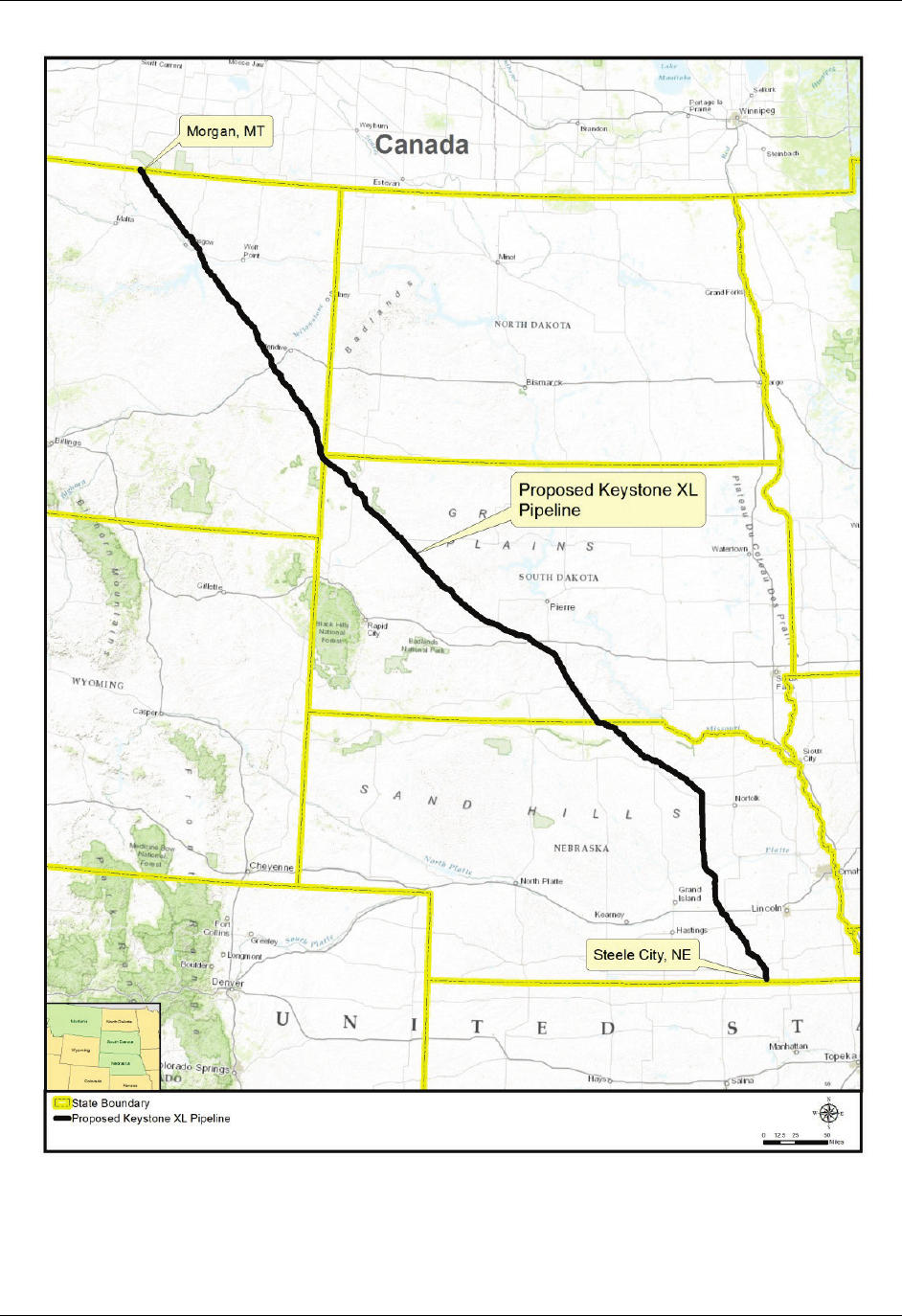
Final Supplemental Environmental Impact Statement Executive Summary
Keystone XL Project
ES-2
Figure ES-1 Proposed Keystone XL Project Route

Final Supplemental Environmental Impact Statement Executive Summary
Keystone XL Project
ES-3
In November 2011, the Department determined that
additional information was needed to fully evaluate the
application—in particular, information about alternative
routes within Nebraska that would avoid the NDEQ-
identified Sand Hills Region. In late December 2011,
Congress adopted a provision of the Temporary Payroll
Tax Cut Continuation Act that sought to require the
President to make a decision on the Presidential Permit
for the 2011 Final EIS route within 60 days. That
deadline did not allow sufficient time to prepare a
rigorous, transparent, and objective review of an
alternative route through Nebraska. As such, the
Presidential Permit was denied.
In February 2012, Keystone informed the Department
that it considered the Gulf Coast portion of the
originally proposed pipeline project (from Cushing,
Oklahoma, to the Gulf Coast area) to have independent
economic utility, and indicated that it intended to
proceed with construction of that pipeline as a separate
project, the Gulf Coast Project (see Figure ES-2). The
Gulf Coast Project did not require a Presidential Permit
because it does not cross an international border.
Construction on the Gulf Coast Project was recently
completed.
On May 4, 2012, Keystone filed a new Presidential
Permit application for the Keystone XL Project. The
proposed Project has a new route and a new stated
purpose and need. The new proposed route differs from
the 2011 Final EIS Route in two significant ways: 1) it
would avoid the environmentally sensitive NDEQ-
identified Sand Hills Region and 2) it would terminate
at Steele City, Nebraska. From Steele City, existing
pipelines would transport the crude oil to the Gulf
Coast area. In other words, the proposed Project no
longer includes a southern segment and instead runs
from Montana to Steele City, Nebraska.
In addition to the NDEQ-identified Sand Hills Region,
the proposed Project route would avoid other areas in
Nebraska (including portions of Keya Paha County)
that have been identified by the NDEQ as having soil
and topographic characteristics similar to the Sand Hills
Region. The proposed Project route would also avoid or
move further away from water wellhead protection
areas for the villages of Clarks and Western, Nebraska.
Figure ES-3 compares the 2011 Final EIS route and the
proposed Project route.
The proposed route in Montana and South Dakota is
largely unchanged from the route analyzed in the 2011
Final EIS except for minor modifications that Keystone
made to improve constructability and in response to
landowner requests (see Figure ES-3).
The Department, after discussions with the USEPA and
the Council on Environmental Quality (CEQ),
determined consistent with NEPA that issuance of the
new Presidential Permit would constitute a major
federal action that may have significant environmental
impact, and that it would prepare a supplement to the
2011 Final EIS for the new application. This
Supplemental EIS provides a thorough analysis of the
environmental impacts from the proposed Project; it has
been revised, expanded, and updated to include a
comprehensive review of the new route in Nebraska as
well as any significant new circumstances or
information that is now available and relevant to the
overall proposed Project.
To assist in preparing this Supplemental EIS, the
Department retained an environmental consulting firm,
Environmental Resources Management (ERM). ERM
was selected pursuant to the Department’s interim
guidance on the selection of independent third-party
contractors. This guidance is designed to ensure that no
conflicts of interest exist between the contractor and the
applicant and that any perceived conflicts that would
impair the public’s confidence in the integrity of the
work are mitigated or removed. ERM works at the sole
and exclusive instruction of the Department and is not
permitted to communicate with Keystone unless
specifically directed to do so by Department officials.
On June 15, 2012, through a Notice of Intent, the
Department solicited public comments for
consideration in establishing the scope and content of
this Supplemental EIS. The scoping period extended
from June 15 to July 30, 2012. In total, an estimated
406,712 letters, cards, emails, e-comments, or
telephone conversation records (henceforth referred to
as submissions) were received from the public,
agencies, and other interested groups and stakeholders
during the scoping period. In March 2013, the
Department issued a Draft Supplemental EIS that
included new analysis and analysis built upon the work
completed in the 2011 Final EIS, as well as the
estimated 406,712 submissions mentioned above that
were received during the 2012 scoping process.
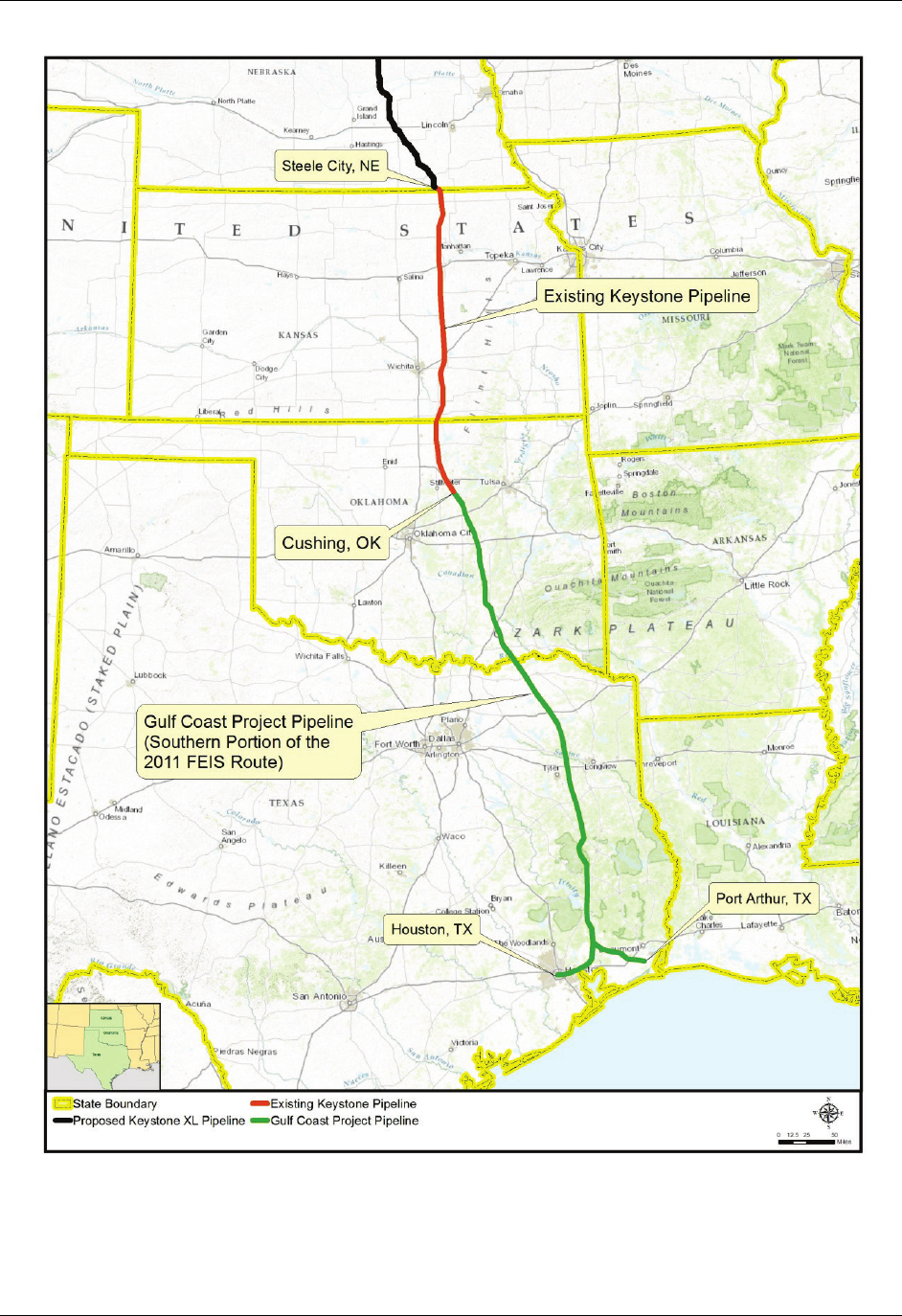
Final Supplemental Environmental Impact Statement Executive Summary
Keystone XL Project
ES-4
Figure ES-2 Gulf Coast Project Route
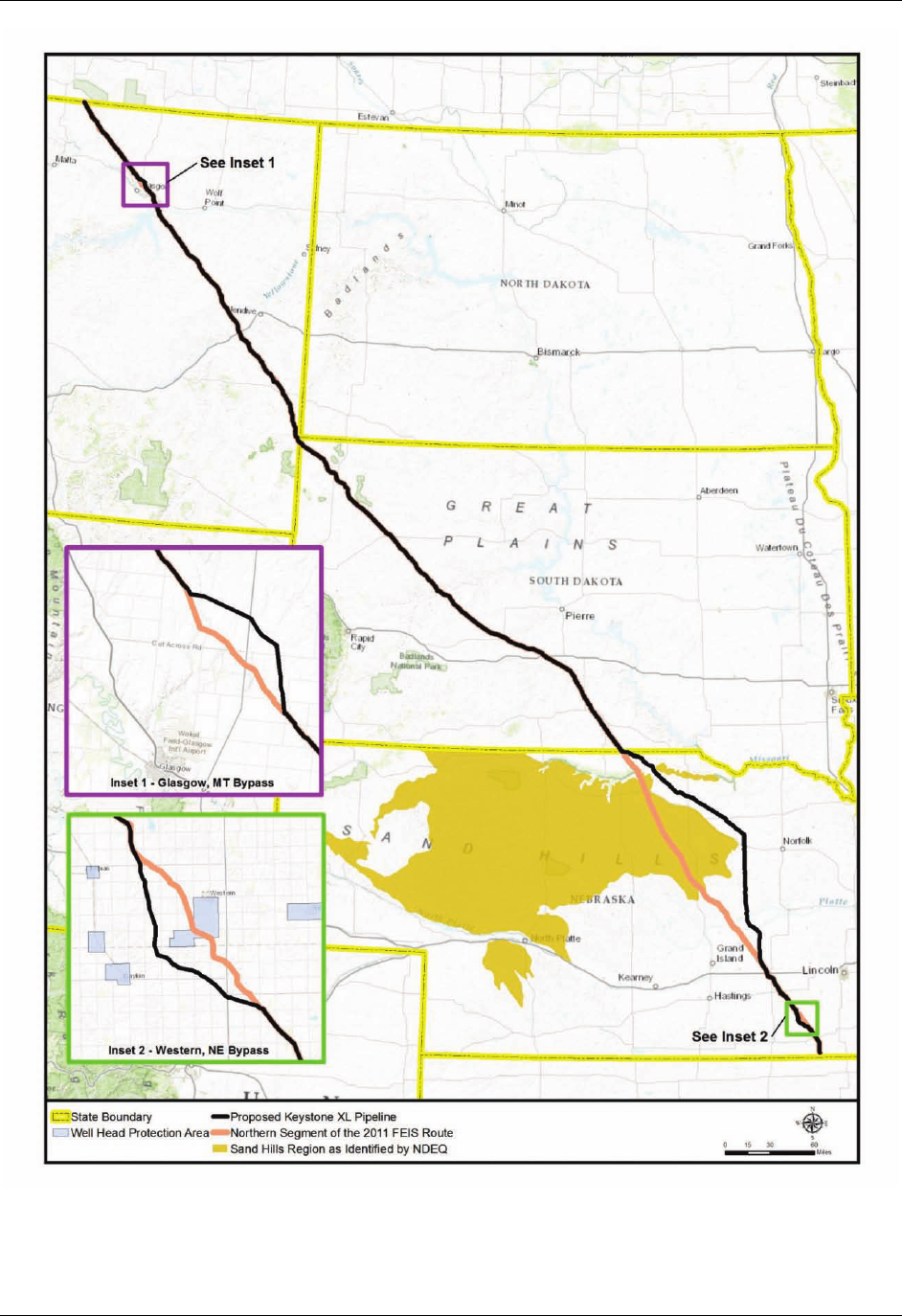
Final Supplemental Environmental Impact Statement Executive Summary
Keystone XL Project
Note: The 2011 Final EIS route is also referred to in this Final Supplemental EIS as the 2011 Steele City Segment Alternative.
Figure ES-3 Comparison of Proposed Project to 2011 Final EIS Route
ES-5

Final Supplemental Environmental Impact Statement Executive Summary
Keystone XL Project
ES-6
ES.1.3 Public Comments Received
Regarding the Draft
Supplemental EIS
Following publication of the 2013 Draft Supplemental
EIS, the Department invited the public to comment on
the document. Electronic versions were made available
for download, and hard copies were made available in
public libraries along the proposed pipeline route. Hard
and electronic copies of the Draft Supplemental EIS
were sent to interested Indian tribes, agencies, elected
and appointed officials, non-governmental
organizations (NGOs), and other parties. The
Department also solicited input at a public meeting held
on April 18, 2013 in Grand Island, Nebraska. In total,
the Department received an estimated 1,513,249
submissions during the public comment period for the
Draft Supplemental EIS. Submissions were made by
federal, state, and local representatives, members of the
public, government agencies, Indian tribes, NGOs, and
other interested groups and stakeholders. Submissions
made by the public on the Draft Supplemental EIS were
posted on www.regulations.gov.
Of this total number of submissions, an estimated
1,496,396 submissions (99 percent of the total) were
form letters sponsored by NGOs. The remaining 16,853
submissions were identified as unique submissions. All
submissions were evaluated and addressed, as
appropriate, in this Supplemental EIS. Some of the
most frequent comment topics included:
• Concerns that the 2013 Draft Supplemental EIS did
not adequately address the greenhouse gas (GHG)
and climate change effects of the extraction,
processing, and use of the crude oil that the
proposed Project would carry;
• Concerns that potential releases from the proposed
Project (i.e., spills) could pollute major
groundwater resources such as the Ogallala
Aquifer;
• Concerns that the 2013 Draft Supplemental EIS did
not adequately address the impacts of bitumen
extraction in Canada;
• Concerns about the contractor and subcontractor
selection process for preparing this Supplemental
EIS;
• Concerns that the crude oil transportation market
was not adequately analyzed;
• Suggestions that the existing Keystone Pipeline
right-of-way (ROW) be considered in lieu of the
currently proposed pipeline route; and
• Questions about the accuracy of job creation
estimates for construction and operation of the
proposed Project, as well as the types, locations,
and hiring preferences of those jobs.
ES.1.4 About the Final Supplemental EIS
This Supplemental EIS for the proposed Keystone XL
pipeline project builds on the analysis provided in the
2011 Final EIS and the 2013 Draft Supplemental EIS
and is now available for download by the public.
Moreover, this Supplemental EIS has been distributed
to participating federal and state agencies, elected
officials, media organizations, Indian tribes, private
landowners, and other interested parties. Printed copies
have also been distributed to public libraries along the
proposed pipeline route.
In completing this Supplemental EIS, the Department
took into consideration the over 1.5 million submissions
received. In response to these comments, the
Department has revised the text from the 2013 Draft
Supplemental EIS for the proposed Project. This Final
Supplemental EIS includes the latest available
information on the proposed Project resulting from
ongoing discussions with federal, state, and local
agencies. It also describes updated analysis of the
potential effects (including direct, indirect, and
cumulative effects) of the proposed Project and
alternatives on various resources. The analysis reflects
inputs from other U.S. government agencies and was
reviewed through an interagency process.
ES.2.0 OVERVIEW OF PROPOSED
PROJECT
ES.2.1 Proposed Project Purpose and Need
According to the application submitted by Keystone,
the primary purpose of the proposed Project is to
provide the infrastructure to transport crude oil from the
border with Canada to delivery points in the United
States (primarily to the Gulf Coast area) by connecting
to existing pipeline facilities near Steele City,
Nebraska. The proposed Project is meant to respond to
the market demand of refineries for crude oil of the
kind found in Western Canada (often called heavy
crude oil). The proposed Project would also provide
transportation for the kind of crude oil found within the
Bakken formation of North Dakota and Montana (often
called light crude oil).
The proposed Project would have the capacity to
deliver up to 830,000 bpd, of which 730,000 bpd of
capacity has been set aside for WCSB crude oil and the
remaining 100,000 bpd of capacity set aside for
Williston Basin (Bakken) crude oil. Keystone has
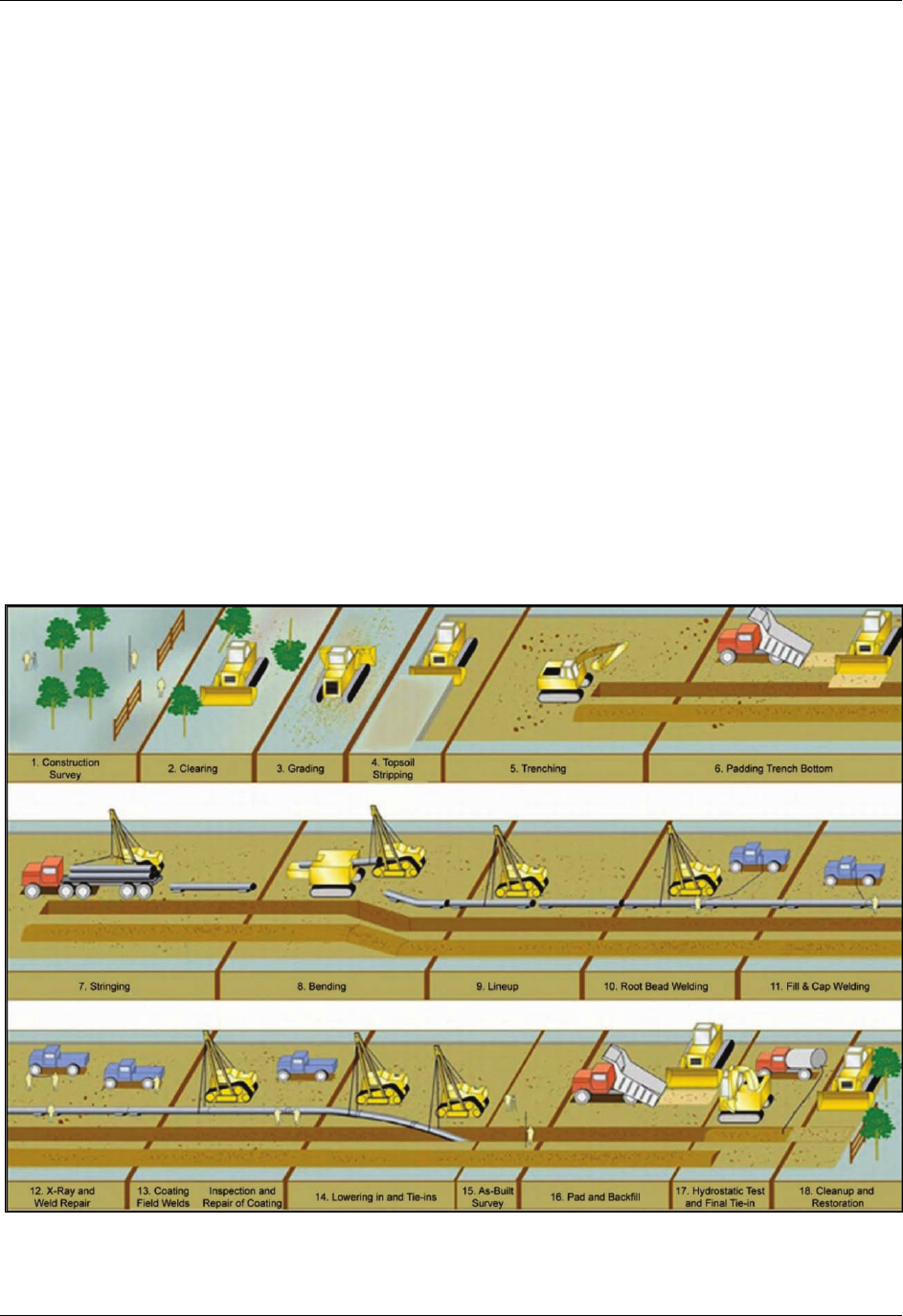
Final Supplemental Environmental Impact Statement Executive Summary
Keystone XL Project
represented that it has firm commitments to transport
approximately 555,000 bpd of heavy crude oil from
producers in the WCSB, as well as 65,000 bpd of crude
oil from the Bakken. The ultimate mixture and quantity
of crude oils transported by the proposed Project over
its lifetime would be determined by market demand.
There is existing demand for crude oil—particularly
heavy crude oil—at refiners in the Gulf Coast area, but
the ultimate disposition of crude oil that would be
transported by the proposed Project, as well as any
refined products produced from that crude oil, would
also be determined by market demand and applicable
law.
ES.2.2 Proposed Project Description
The proposed Project would consist of approximately
875 miles of new 36-inch-diameter pipeline and related
facilities for transport of WCSB and Bakken crude oil,
the latter from an oil terminal near Baker, Montana.
Crude oil carried in the proposed Project would be
delivered to existing pipeline facilities near Steele City,
Nebraska, for onward delivery to refineries in the Gulf
Coast area. The proposed Project would also include
two pump stations (one new and one expanded) along
the existing Keystone Pipeline in Kansas
(see Figure ES-5).
Construction of the proposed Project would include the
pipeline itself plus various aboveground ancillary
facilities (e.g., access roads, pump stations, and
construction camps) and connected actions. Figure
ES-4 illustrates the construction sequence that would be
followed for the proposed Project.
Construction of the proposed Project would generally
require a 110-foot-wide temporary ROW and is
expected to last 1 to 2 years. After construction, the
proposed Project would generally maintain a 50-foot-
wide permanent ROW easement over the pipeline in
Montana (approximately 285 miles), South Dakota
(approximately 316 miles), and Nebraska
(approximately 274 miles).
Keystone would have access to property within the
easement, but property owners would retain the ability
to farm and conduct other limited activities within the
easement. The permanent aboveground ancillary
facilities would include electrically operated pump
stations, mainline valves, and permanent access roads.
Figure ES-4 Keystone XL, Typical Pipeline Construction Sequence
ES-7
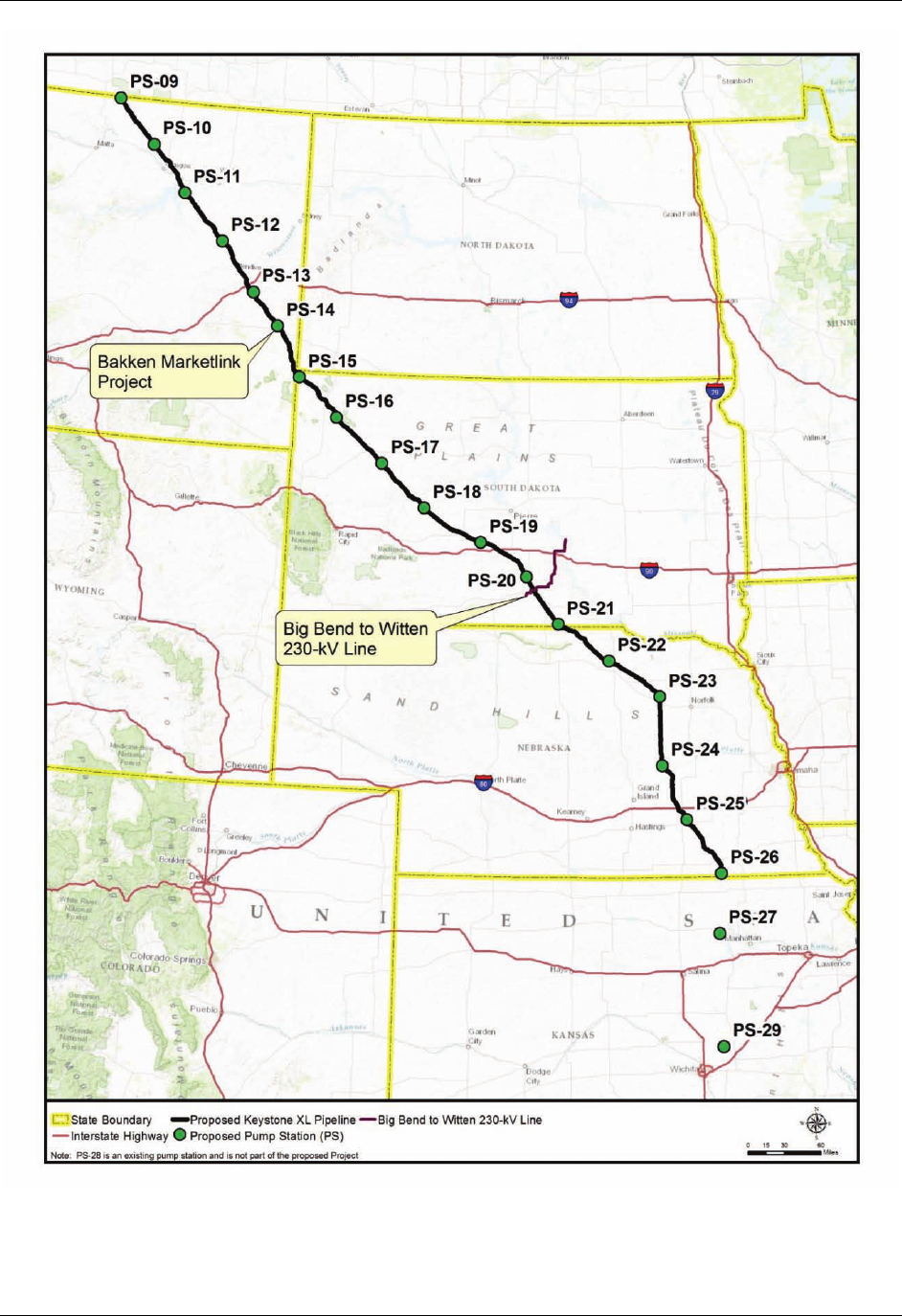
Final Supplemental Environmental Impact Statement Executive Summary
Keystone XL Project
Figure ES-5 Proposed Project Overview
ES-8

Final Supplemental Environmental Impact Statement Executive Summary
Keystone XL Project
ES-9
The U.S. portion of the proposed Project is estimated to
cost approximately $3.3 billion, and would be paid for
by Keystone. If permitted, the pipeline would begin
operation approximately 2 years after final approvals
were received, with the actual in-service date dependent
on construction as well as obtaining any additional
permits, approvals, and authorizations necessary before
operations can commence.
ES.2.2.1 The Bakken Marketlink Project
Keystone Marketlink, LLC, a wholly owned subsidiary
of TransCanada Pipelines Limited, would construct and
operate the Bakken Marketlink Project. This project
would include a 5-mile pipeline, pumps, meters, and
storage tanks to supply Bakken crude oil to the
proposed pipeline from the Bakken Marketlink pipeline
system in North Dakota and Montana. Two crude oil
storage tanks would be built near Baker, Montana, as
part of this project. This project would be able to
deliver up to 100,000 bpd of crude oil, and has
commitments for approximately 65,000 bpd.
ES.2.2.2 Big Bend to Witten 230-kV
Electrical Transmission Line
The Western Area Power Administration (Western) has
determined that providing reliable electricity for
operation of the proposed Project requires the
construction of a new 230-kilovolt (kV) transmission
line originating at the Fort Thompson/Big Bend Dam
area in South Dakota and extending south to the
existing Witten Substation, near Pump Stations 20 and
21. To meet these demands, Western would repurpose
existing transmission infrastructure and construct new
infrastructure between the Big Bend Dam and a
proposed Big Bend Substation. The Basin Electric
Power Cooperative would construct a new 76-mile,
230-kV transmission line from the Big Bend Substation
to the existing Witten Substation, and would operate
both the transmission line and the Big Bend Substation.
ES.2.2.3 Electrical Distribution Lines and
Substations
Electrical power for the proposed Project would be
obtained from local power providers. These power
providers would construct the necessary substations and
transformers, and would either use existing service lines
or construct new service lines to deliver electrical
power to the specified point of use (e.g., pump stations
and mainline valves), which would be located at
intervals along the proposed Project route.
ES.3.0 OVERVIEW OF PETROLEUM
MARKETS
The scope and content of the market analysis in this
Supplemental EIS were informed by public and
interagency comments as well as new information that
was not previously available. Among the notable
updates to this analysis are revised modeling to
incorporate evolving market conditions, more extensive
information on the logistics and economics of crude by
rail, and a more detailed analysis of supply costs to
inform conclusions about production implications.
The updated market analysis in this Supplemental
EIS—similar to the market analysis sections in the 2011
Final EIS and 2013 Draft Supplemental EIS—
concludes that the proposed Project is unlikely to
significantly affect the rate of extraction in oil sands
areas (based on expected oil prices, oil-sands supply
costs, transport costs, and supply-demand scenarios).
The Department conducted this analysis, drawing on a
wide variety of data and leveraging external expertise.
ES.3.1 Summary of Market Analysis
The 2011 Final EIS was developed contemporaneously
with the start of strong growth in domestic light crude
oil supply from so-called tight oil formations, such as
those formations found in North Dakota’s Bakken
region. Domestic production of crude oil has increased
significantly, from approximately 5.5 million bpd in
2010 to 6.5 million bpd in 2012 and 7.5 million bpd by
mid-2013. Rising domestic crude production is
predominantly light crude, and it has replaced foreign
imports of light crude oil. However, demand persists for
imported heavy crude by U.S. refineries that are
optimized to process that kind of oil. Meanwhile,
Canadian production of bitumen from the oil sands
continues to grow, the vast majority of which is
currently exported to the United States to be processed
by U.S. refineries that want heavy crude oil. North
American production growth and logistics constraints
have contributed to significant discounts on the price of
landlocked crude and have led to growing volumes of
crude shipped by rail in the United States and, more
recently, Canada.
Both the 2011 Final EIS and the Draft Supplemental
EIS published in March 2013 discussed the
transportation of Canadian crude by rail as a possibility.
Due to market developments since then, this
Supplemental EIS notes that the transportation of
Canadian crude by rail is already occurring in
substantial volumes. It is estimated that approximately
180,000 bpd of Canadian crude oil is already traveling
by rail (see Figure ES-6).

Final Supplemental Environmental Impact Statement Executive Summary
Keystone XL Project
ES-10
0
20,000
40,000
60,000
80,000
100,000
120,000
140,000
160,000
180,000
200,000
Barrels per Day
Figure ES-6 Estimated Crude Oil Transported by Rail from WCSB, bpd
The industry has been making significant investments
in increasing rail transport capacity for crude oil out of
the WCSB. Figure ES-7 illustrates the increase in rail
loading and unloading terminals between 2010 and
2013. Rail loading facilities in the WCSB are estimated
to have a capacity of approximately 700,000 bpd of
crude oil, and by the end of 2014 this will likely
increase to more than 1.1 million bpd. Most of this
capacity (approximately 900,000 to 1 million bpd) is in
areas that produce primarily heavy crude oil (both
conventional and oil sands), or is being connected by
pipelines to those oil production areas.
Various uncertainties underlie the projections upon
which this Supplemental EIS partially relies. In
recognition of the uncertainty of future market
conditions, the analysis included updated modeling
about the sensitivity of the market to some of
these elements.
Updated information on rail transportation and oil
market trends, particularly rising U.S. oil production,
was incorporated in oil market modeling. This
modeling was developed in response to comments
received on the Draft Supplemental EIS. To help
account for key uncertainties about oil production,
consumption, and transportation, the modeling
examined 16 different scenarios that combine various
supply-demand assumptions and pipeline constraints.
Modeled cases test supply and demand projections
based on the official energy forecasts of independent
U.S. Energy Information Administration’s (EIA) 2013
Annual Energy Outlook that correspond to uncertainties
raised in public comments, including potential higher-
than-expected U.S. supply, lower-than-expected U.S.
demand, and higher-than-expected oil production in
Latin America.
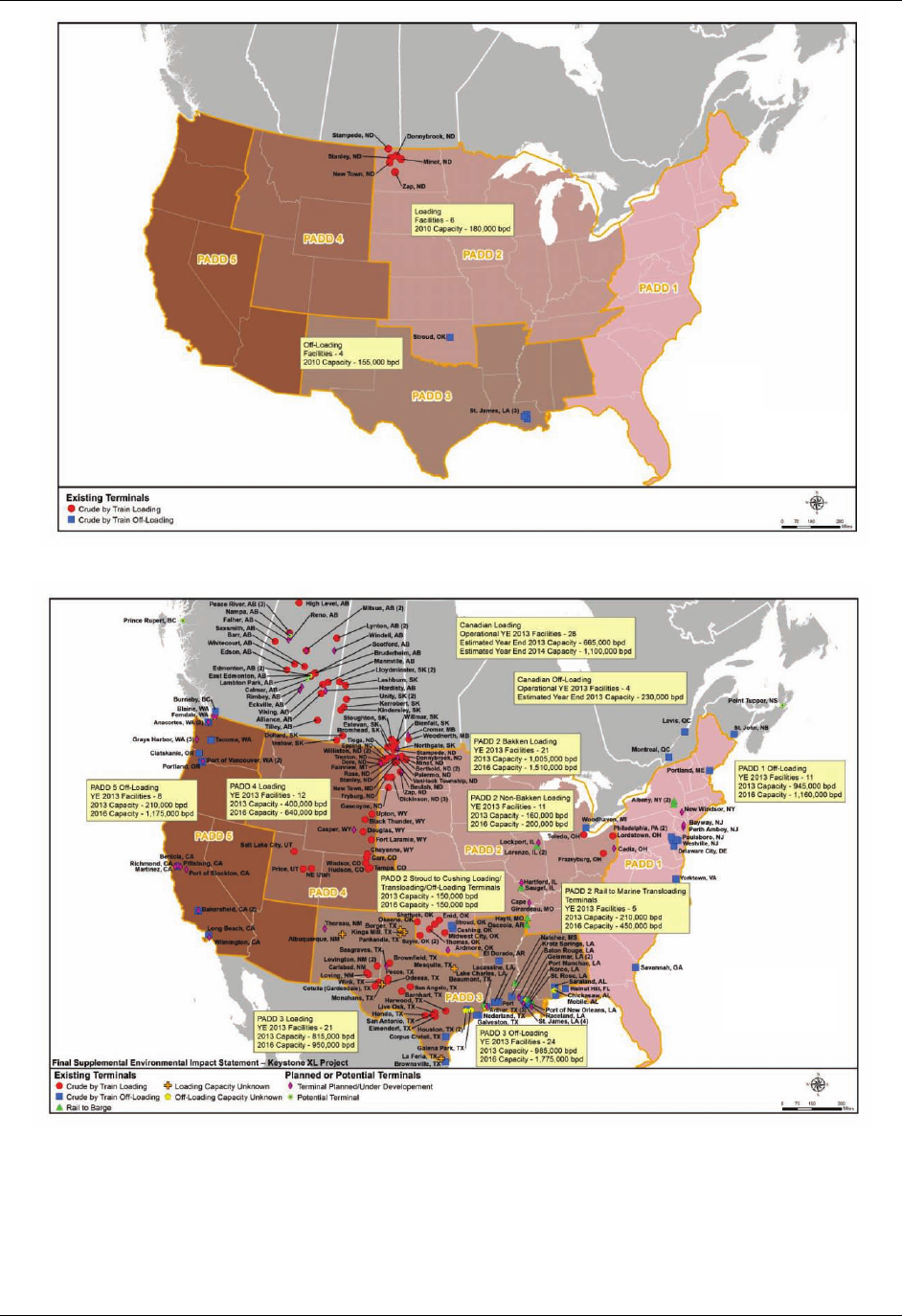
December
2013
December
2010
2010
ES-11
Final Supplemental Environmental Impact Statement Executive Summary
Keystone XL Project
Note: These estimates do not include a facility being constructed in Edmonton, Canada, with a design capacity of 250,000 bpd
(100,000 bpd expected to be operational by the end of 2014) that was announced shortly before this Supplemental EIS was
completed. In addition, Altex Energy has plans for a 55,000 bpd loading facility in Vermillion, Alberta.
Figure ES-7 Crude by Train Loading and Off-Loading Facilities in 2010 (top map) and 2013
(bottom map)

Final Supplemental Environmental Impact Statement Executive Summary
Keystone XL Project
ES-12
The supply-demand cases were paired with four
pipeline configuration scenarios: an unconstrained
scenario that allows pipelines to be built without
restrictions; a scenario in which no new cross-border
pipeline capacity to U.S. markets is permitted, but
pipelines from the WSCB to Canada’s east and west
coasts are built; a scenario where new cross-border
capacity between the United States and Canada is
permitted, but Canadian authorities do not permit new
east-west pipelines; and a constrained scenario that
assumes no new or expanded pipelines carrying WCSB
crude are built in any direction.
Updated model results indicated that cross-border
pipeline constraints have a limited impact on crude
flows and prices. If additional east-west pipelines were
built to the Canadian coasts, such pipelines would be
heavily utilized to export oil sands crude due to
relatively low shipping costs to reach growing Asian
markets. If new east-west and cross-border pipelines
were both completely constrained, oil sands crude could
reach U.S. and Canadian refineries by rail.
Varying pipeline availability has little impact on the
prices that U.S. consumers pay for refined products
such as gasoline or for heavy crude demand in the Gulf
Coast. When this demand is not met by heavy Canadian
supplies in the model results, it is met by heavy crude
from Latin America and the Middle East.
Conclusions about the potential effects of pipeline
constraints on production levels were informed by
comparing modeled oil prices to the prices that would
be required to support expected levels of oil sands
capacity growth. Figure ES-8 illustrates existing oil
sands capacity, the estimated supply costs of announced
capacity, and the capacity growth that will be required
to meet EIA and Canadian Association of Petroleum
Producers production projections. Projected prices
generally exceed supply costs for the projects
responsible for future oil sands production growth.
Modeling results indicate that severe pipeline
constraints reduce the prices received by bitumen
producers by up to $8/bbl, but not enough to curtail
most oil sands growth plans or to shut-in existing
production (based on expected oil prices, oil-sands
supply costs, transport costs, and supply-demand
scenarios). These conclusions are based on conservative
assumptions about rail costs, which likely overstate the
cost penalty producers pay for shipping by rail if more
economic methods currently under consideration to ship
bitumen by rail are utilized.
Several analysts and financial institutions have stated
that denying the proposed Project would have
significant impacts on oil sands production. To the
extent that other assessments appear to differ from the
analysis in this report, they typically do so because they
have different focuses, near-term time scales, or
production expectations, and/or include less detailed
data and analysis about rail than this report. While
short-term physical transportation constraints introduce
uncertainty to industry outlooks over the next decade,
new data and analysis in Section 1.4, Market Analysis,
indicate that rail will likely be able to accommodate
new production if new pipelines are delayed or not
constructed.
Over the long term, lower-than-expected oil prices
could affect the outlook for oil sands production, and in
certain scenarios higher transportation costs resulting
from pipeline constraints could exacerbate the impacts
of low prices. The primary assumptions required to
create conditions under which production growth would
slow due to transportation constraints include: 1) that
prices persist below current or most projected levels in
the long run; and 2) that all new and expanded
Canadian and cross-border pipeline capacity, beyond
just the proposed Project, is not constructed.
Above approximately $75 per barrel for West Texas
Intermediate (WTI)-equivalent oil, revenues to oil
sands producers are likely to remain above the long-run
supply costs of most projects responsible for expected
levels of oil sands production growth. Transport
penalties could reduce the returns to producers and, as
with any increase in supply costs, potentially affect
investment decisions about individual projects on the
margins. However, at these prices, enough relatively
low-cost in situ projects are under development that
baseline production projections would likely be met
even with constraints on new pipeline capacity. Oil
sands production is expected to be most sensitive to
increased transport costs in a range of prices around
$65 to $75 per barrel. Assuming prices fell in this
range, higher transportation costs could have a
substantial impact on oil sands production levels—
possibly in excess of the capacity of the proposed
Project—because many in situ projects are estimated to
break even around these levels. Prices below this range
would challenge the supply costs of many projects,
regardless of pipeline constraints, but higher transport
costs could further curtail production.

Final Supplemental Environmental Impact Statement Executive Summary
Keystone XL Project
ES-13
Note: The green shaded areas in the Current and Announced Project Peak Capacity represent the capacity of projects that are
operating or already under construction, which are expected to continue producing and/or remain under development as long as
oil prices are above operating costs. The purple shaded areas represent the capacity of potential projects that would likely only go
forward with oil prices above the stated ranges.
Figure ES-8 Oil Sands Supply Costs (West Texas Intermediate-Equivalent Dollars per Barrel),
Project Capacity, and Production Projections
Oil prices are volatile, particularly over the short-term.
In addition, long-term trends, which drive investment
decisions, are difficult to predict. Specific supply cost
thresholds, Canadian production growth forecasts, and
the amount of new capacity needed to meet them are
uncertain. As a result, the price threshold above which
pipeline constraints are likely to have a limited impact
on future production levels could change if supply costs
or production expectations prove different than
estimated in this analysis.
The dominant drivers of oil sands development are
more global than any single infrastructure project. Oil
sands production and investment could slow or
accelerate depending on oil price trends, regulations,
and technological developments, but the potential
effects of those factors on the industry’s rate of
expansion should not be conflated with the more
limited effects of individual pipelines.

Final Supplemental Environmental Impact Statement Executive Summary
Keystone XL Project
ES-14
ES.4.0 ENVIRONMENTAL
ANALYSIS OF THE
PROPOSED PROJECT
The Department evaluated the potential construction
and operational impacts of the proposed Project and
alternatives across a wide range of environmental
resources. The analysis discusses public and agency
interests and concerns as reflected in the submissions
received during the scoping period and on the 2013
Draft Supplemental EIS, and includes:
• Climate change, including lifecycle (well-to-
wheels [WTW]) GHG emissions associated with
oil sands development, refining, and consumption;
• Potential releases or spills of oil;
• Socioeconomics, including the potential job and
revenue benefits of the proposed Project, as well as
concerns about environmental justice;
• Water resources, including potential effects on
groundwater aquifers (e.g., Ogallala Aquifer) and
surface waters;
• Wetlands;
• Threatened and endangered species;
• Potential effects on geology, soils, other biological
resources (e.g., vegetation, fish, and wildlife), air
quality, noise, land use, recreation, and visual
resources; and
• Cultural resources, including tribal consultation.
ES.4.1 Climate Change
Changes to the Earth’s climate have been observed over
the past century with a global temperature increase of
1.5 degrees Fahrenheit between 1880 and 2012. This
warming has coincided with increased levels of GHGs
in the atmosphere. In order for the Earth’s heat and
energy to remain at a steady state, the solar energy that
is incoming must equal the energy that is radiated into
space (see Figure ES-9). GHGs contribute to trapping
outbound radiation within the troposphere (the layer of
the atmosphere closest to the Earth’s surface), and this
is called the greenhouse effect.
Figure ES-9 The Greenhouse Effect

Final Supplemental Environmental Impact Statement Executive Summary
Keystone XL Project
ES-15
Since the beginning of the Industrial Revolution, the
rate and amount of GHGs have increased as a result of
human activity. The additional GHGs intensify the
greenhouse effect, resulting in a greater amount of heat
being trapped within the atmosphere. The
Intergovernmental Panel on Climate Change, a group of
1,300 independent scientific experts from countries
around the world, in its Fifth Assessment Report
concludes that global warming in the climate system is
unequivocal based on measured increases in
temperature, decrease in snow cover, and higher sea
levels.
This Supplemental EIS evaluates the relationship
between the proposed Project with respect to GHG
emissions and climate change from the following
perspectives:
• The GHG emissions associated with the
construction and operation of the proposed Project
and its connected actions;
• The potential increase in indirect lifecycle (wells-
to-wheels) GHG emissions associated with the
WCSB crude oil that would be transported by the
proposed Project;
• How the GHG emissions associated with the
proposed Project cumulatively contribute to
climate change; and
• An assessment of the effects that future projected
climate change could have in the proposed Project
area and on the proposed Project.
ES.4.1.1 Greenhouse Gas Emissions from the
Proposed Project
The proposed Project would emit approximately
0.24 million metric tons of carbon dioxide (CO
2
)
equivalents (MMTCO
2
e) per year during the
construction period. These emissions would be emitted
directly through fuel use in construction vehicles and
equipment, as well as, land clearing activities including
open burning, and indirectly from electricity usage.
During operations, approximately 1.44 MMTCO
2
e
would be emitted per year, largely attributable to
electricity use for pump station power, fuel for vehicles
and aircraft for maintenance and inspections, and
fugitive methane emissions at connections. The
1.44 MMTCO
2
e emissions would be equivalent to
GHG emissions from approximately 300,000 passenger
vehicles operating for 1 year, or 71,928 homes using
electricity for 1 year.
ES.4.1.2 Lifecycle Analysis
To enable a more comprehensive understanding of the
potential indirect GHG impact of the proposed Project,
it is important to also consider the wider GHG
emissions associated with the crude oil being
transported by the proposed Project. A lifecycle
approach was used to evaluate the GHG implications of
the WCSB crudes that would be transported by the
proposed Project compared to other crude oils that
would likely be replaced or displaced by those WCSB
crudes in U.S. refineries. A lifecycle analysis is a
technique used to evaluate the environmental aspects
and impacts (in this case GHGs) that are associated
with a product, process, or service from raw materials
acquisition through production, use, and end-of-life.
The lifecycle analysis considered wells-to-wheels GHG
emissions, including extraction, processing,
transportation, refining, and refined product use (such
as combustion of gasoline in cars) of WCSB crudes
compared to other reference heavy crudes. The lifecycle
analysis also considered the implications associated
with other generated products during the lifecycle
stages (so-called co-products) such as petroleum coke.
WCSB crudes are generally more GHG intensive than
other heavy crudes they would replace or displace in
U.S. refineries, and emit an estimated 17 percent more
GHGs on a lifecycle basis than the average barrel of
crude oil refined in the United States in 2005. The
largest single source of GHG emissions in the lifecycle
analysis is the finished-fuel combustion of refined
petroleum fuel products, which is consistent for
different crude oils, as shown in Figure ES-10.
The total lifecycle emissions associated with
production, refining, and combustion of 830,000 bpd of
oil sands crude oil transported through the proposed
Project is approximately 147 to 168 MMTCO
2
e per
year. The annual lifecycle GHG emissions from
830,000 bpd of the four reference crudes examined in
this Supplemental EIS are estimated to be 124 to
159 MMTCO
2
e. The range of incremental GHG
emissions for crude oil that would be transported by the
proposed Project is estimated to be 1.3 to 27.4
MMTCO
2
e annually. The estimated range of potential
emissions is large because there are many variables
such as which reference crude is used for the
comparison and which study is used for the
comparison.
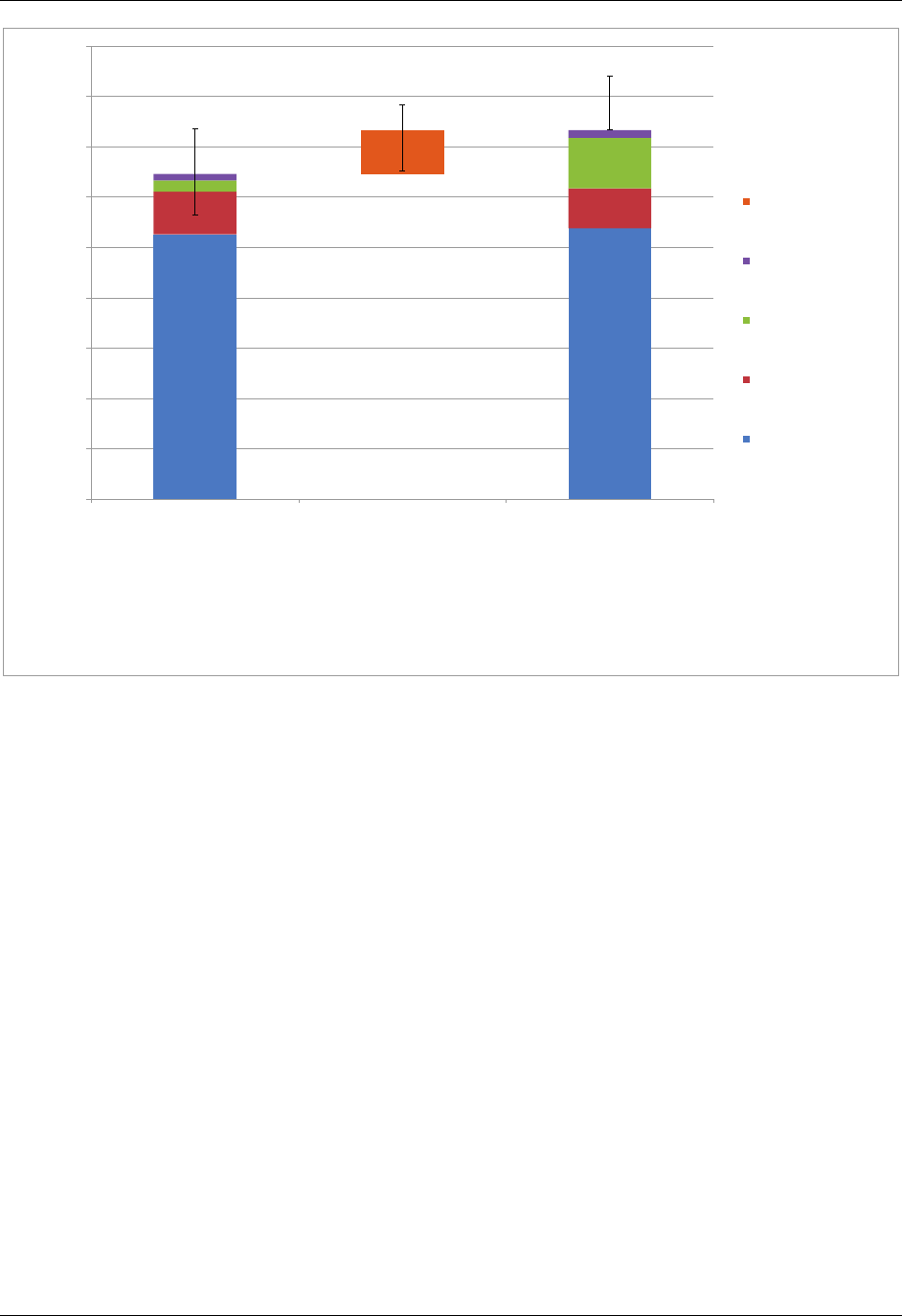
Final Supplemental Environmental Impact Statement Executive Summary
Keystone XL Project
ES-16
0
20
40
60
80
100
120
140
160
180
2013 Current Baseline, 830,000 bpd of
reference crude(s)
Incremental Emissions (excluding
consideration of Market Analysis)
830,000 bpd oil sands production
GHG emissions (MMTCO2e/yr)
Incremental GHG
Emissions **
Coproducts & net
petroleum coke
emissions
Extraction and mining
Refining
Combustion and
transportation
* Note: The orange bar represents incremental emissions. The bar itself is for a single crude (Mexican Maya) from the TIAX study. The range bar
is representative of all studies and reflects the 1.3 to 27.4 MMTCO2e annual incremental emissions presented in the Final Supplemental EIS.
** Incremental Emissions: This represents the difference between the 2013 Current Baseline and the 830,000 bpd Oil Sands Production, and
excludes consideration of the Market Analysis. These Incremental Emissions represent the potential increase in emissions attributable to the
proposed Project if one assumed that approval or denial of the proposed Project would directly result in a change in production of 830,000 bpd
of oil sands crudes in Canada. However, as set forth in Section 1.4, Market Analysis, such a change is not likely to occur.
*
Note: See Figure 4.14.3-7 in Section 4.14.3.5, Incremental GHG Emissions, for a full description of the information presented in
this figure.
Figure ES-10 Incremental Well-to-Wheels GHG Emissions from WCSB Oil Sands Crudes
Compared to Well-to-Wheels GHG Emissions from Displacing Reference Crudes
The above estimates represent the total incremental
emissions associated with production and consumption
of 830,000 bpd of oil sands crude compared to the
reference crudes. These estimates represent the
potential increase in emissions attributable to the
proposed Project if one assumed that approval or denial
of the proposed Project would directly result in a
change in production of 830,000 bpd of oil sands crudes
in Canada (See Section 4.14.4.2, Emissions and
Impacts in Context, for additional information on
emissions associated with increases in oil sands
production). However, as set forth in Section 1.4,
Market Analysis, such a change is not likely to occur
under expected market conditions. Section 1.4 notes
that approval or denial of any one crude oil transport
project, including the proposed Project, is unlikely to
significantly impact the rate of extraction in the oil
sands or the continued demand for heavy crude oil at
refineries in the United States based on expected oil
prices, oil-sands supply costs, transport costs, and
supply-demand scenarios.
The 2013 Draft Supplemental EIS estimated how oil
sands production would be affected by long-term
constraints on pipeline capacity (if such constraints
resulted in higher transportation costs) if long-term
WTI-equivalent oil prices were less than $100 per
barrel. The Draft Supplemental EIS also estimated a
change in GHG emissions associated with such changes
in production. The additional data and analysis included
in this Supplemental EIS provide greater insights into
supply costs and the range of prices in which pipeline
constraints would be most likely to impact production.
If WTI-equivalent prices fell to around approximately
$65 to $75 per barrel, if there were long-term
constraints on any new pipeline capacity, and if such
constraints resulted in higher transportation costs, then
there could be a substantial impact on oil sands

Final Supplemental Environmental Impact Statement Executive Summary
Keystone XL Project
ES-17
production levels. As noted in E.S.3.1, Summary of
Market Analysis, this estimated price threshold could
change if supply costs or production expectations prove
different than estimated in this analysis. This is
discussed in Section 1.4.5.4, Implications for
Production.
ES.4.1.3 Climate Change Effects
The total direct and indirect emissions associated with
the proposed Project would contribute to cumulative
global GHG emissions. However, emissions associated
with the proposed Project are only one source of
relevant GHG emissions. In that way, GHG emissions
differ from other impact categories discussed in this
Supplemental EIS in that all GHG emissions of the
same magnitude contribute to global climate change
equally, regardless of the source or geographic location
where they are emitted.
As part of this Supplemental EIS, future climate change
scenarios and projections developed by the
Intergovernmental Panel on Climate Change and peer-
reviewed downscaled models were used to evaluate the
effects that climate change could have on the proposed
Project, as well as the environmental consequences
from the proposed Project.
Assuming construction of the proposed Project were to
occur in the next few years, climate conditions during
the construction period would not differ substantially
from current conditions. However, during the
subsequent operational time period, the following
climate changes are anticipated to occur regardless of
any potential effects from the proposed Project:
• Warmer winter temperatures;
• A shorter cool season;
• A longer duration of frost-free periods;
• More freeze-thaw cycles per year (which could
lead to an increased number of episodes of soil
contraction and expansion);
• Warmer summer temperatures;
• Increased number of hot days and consecutive hot
days; and
• Longer summers (which could lead to impacts
associated with heat stress and wildfire risks).
This Supplemental EIS assessed whether the projected
changes in the climate could further influence the
impacts and effects attributable to the proposed Project.
Elevated effects due to projected climate change could
occur to water resources, wetlands, terrestrial
vegetation, fisheries, and endangered species, and could
also contribute to air quality impacts. In addition, the
statistical risk of a pipeline spill could be increased by
secondary effects brought on by climatic change such
as increased flooding and drought. However, this
increased risk would still be much less than the risk of
spills from other causes (such as third-party damage).
Climate change could have an effect on the severity of a
spill such that it could be reduced in drought conditions
but increased during periods of increased precipitation
and flooding.
ES.4.2 Potential Releases
The proposed Project would include processes,
procedures, and systems to prevent, detect, and mitigate
potential oil spills.
Many commenters raised concerns regarding the
potential environmental effects of a pipeline release,
leak, and/or spill. Impacts from potential releases from
the proposed Project were evaluated by analyzing
historical spill data. The analysis identified the types of
pipeline system components that historically have been
the source of spills, the sizes of those spills, and the
distances those spills would likely travel. The resulting
potential impacts to natural resources, such as surface
waters and groundwater, were also evaluated as well as
planned mitigation measures designed to prevent,
minimize, and respond to spills.
ES.4.2.1 Historical Pipeline Performance
In response to numerous comments regarding pipeline
performance, the Department analyzed historical
incident data within the PHMSA and National
Response Center incident databases to understand what
has occurred with respect to crude oil pipelines and the
existing Keystone Pipeline system.
Table ES-1 summarizes hazardous liquid pipeline
incidents reported to the PHMSA across the United
States from January 2002 through July 2012 and shows
the breakdown of incidents by pipeline component. A
total of 1,692 incidents occurred, of which 321 were
pipe incidents and 1,027 were involving different
equipment components such as tanks, valves, or pumps.

Final Supplemental Environmental Impact Statement Executive Summary
Keystone XL Project
ES-18
Table ES-1 Summary of PHMSA Database Incidents
a
(January 2002 to July 2012)
Incident Category Incidents Incident Sub-Category Incidents
Crude oil pipeline 1,692
Crude oil mainline pipe incidents 321
Crude oil pipeline, equipment incidents (not mainline pipe) 1,027
Crude oil pipeline system, unspecified elements 344
Crude oil mainline
pipe
321
16-inch or greater diameter 71
8-inch or 15-inch diameter 154
Less than 8-inch diameter 52
Diameter not provided 44
Crude oil pipeline,
equipment (not
mainline pipe)
1,027
Tanks 93
Valves 25
Other discrete elements (pumps, fittings, etc.) 909
a
Incident as used in the Final Supplemental EIS is in reference to a PHMSA and/or a National Response Center record of a
reportable spill or accident found within their respective databases.
To assess the likelihood of releases from the proposed
Project, risk assessments were conducted addressing
both the potential frequency of releases and the
potential crude oil spill volumes associated with the
releases. The assessments used three hypothetical spill
volumes (small, medium, and large scenarios) to
represent the range of reported spills in the PHMSA’s
spills database. Table ES-2 shows these spill volumes
and the probabilities of such volumes.
Most spills are small. Of the 1,692 incidents between
2002 and 2012 (shown in Table ES-1), 79 percent of
the incidents were in the small (zero to 50 bbl) range,
equivalent to a spill of up to 2,100 gallons (see Table
ES-2). Four percent of the incidents were in the large
(greater than 1,000 bbl) range.
ES.4.2.1.1
Small and Medium Spills
The potential impacts from small spills of oil would
typically be confined to soil immediately surrounding
the spill, and would have little effect on nearby natural
resources. These types of spills would generally be
detected by maintenance or operations personnel and
addressed through repair of the leak and remediation of
the impacted area by removal of impacted soil and
cleaning of stained concrete or containment areas.
With medium spills, a release could occur as a
subsurface or surface event depending upon the cause.
Similar to a small spill, a slow subsurface leak could
potentially reach a groundwater resource and, if the
leak is faster than the soil can absorb the oil, could seep
to the ground surface. Once the migrating oil leaves the
release site, impacts to soil, vegetation, wildlife, and
surface water along the flow path would occur.
Depending on how quickly it is remediated, some of the
oil might tend to pool in low areas and potentially
infiltrate back into the soil and to groundwater
depending on the depth to groundwater.
ES.4.2.1.2
Large Spills
With a large spill, the majority of the spill volume
would migrate away from the release site. The potential
impacts from a large spill would be similar to the
impacts from the medium-sized spill, but on a much
larger scale. More oil would seep into the soil over a
larger area and could infiltrate deeper into the soil.
Once the spill reaches the surface, the oil would flow
following topographic gradient or lows (e.g., gullies,
roadside drainage ditches, culverts, or storm sewers)
and eventually to surface water features.
Table ES-2 Spill Scenarios Evaluated in Supplemental EIS
Spill Volume Scenario Frequency
a
Small: Less than 50 bbl (2,100 gallons) 79%
Medium: 50–1,000 bbl (2,100–42,000 gallons) 17%
Large: >1,000 bbl (>42,000 gallons) 4%
a
Indicates the share of all releases reported in the PHMSA database that fit each spill volume scenario.

Final Supplemental Environmental Impact Statement Executive Summary
Keystone XL Project
ES-19
If the release enters flowing water or other surface
water features, the extent of the release could become
very large, potentially affecting soil, wildlife, and
vegetation along miles of river and shoreline. As has
been seen in recent large spills, sinking oil can be
deposited in river or stream bottoms and become a
continual source of oil release over time.
ES.4.2.2 Prevention and Mitigation
In order to reduce the risk of spills, if permitted
Keystone has agreed to incorporate additional
mitigation measures in the design, construction, and
operation of the proposed Keystone XL Project, in
some instances above what is normally required,
including:
• 59 Special Conditions recommended by PHMSA;
• 25 mitigation measures recommended in the
Battelle and E
x
ponent risk reports; and
• 11 additional mitigation measures.
Many of these mitigation measures relate to reductions
in the likelihood of a release occurring. Other measures
provide mitigation that reduces the consequences and
impact of a spill should such an event occur. Mitigation
measures are compiled in Appendix Z, Compiled
Mitigation Measures, of this Supplemental EIS.
Mitigation measures are actions that, if the proposed
Project is determined to be in the national interest,
Keystone would comply with as conditions of a
Presidential Permit.
If a spill occurred, the degree of impact to water,
people, livestock, soil, and other natural resources
would depend on the distance from the spill source. A
large spill of 20,000 bbl, for example, could have a
combined overland and groundwater spreading of up to
2,264 feet (or 0.42 miles) from a release point. Oil
could spread on flat ground up to 1,214 feet from the
proposed pipeline, depending on the volume spilled. If
oil reached groundwater, components in the oil, such as
benzene, could spread in groundwater up to an
additional 1,050 feet downgradient (essentially,
downhill underground and on land) of the spill point.
The proposed Project would, if permitted, include
processes, procedures, and systems to prevent, detect,
and mitigate potential oil spills that could occur during
construction and operation of the pipeline. These would
include a Spill Prevention, Control, and
Countermeasure Plan as well as a Construction,
Mitigation, and Reclamation Plan (CMRP). In the event
of a large leak, Supervisory Control and Data
Acquisition sensors would automatically detect
noticeable changes in pipeline pressure and flow rates.
Leaks and spills could also be identified during routine
aerial surveillance along the pipeline ROW. In addition,
Keystone would be required, if permitted, to prepare an
Emergency Response Plan that would contain further
detail on response procedures and would be reviewed
by the PHMSA prior to granting permission to operate
the proposed pipeline. Keystone would incorporate into
these plans lessons learned from past spills such as the
pipeline rupture in 2010 that affected the Kalamazoo
River (Marshall, Michigan). For example, Keystone
would, if permitted, procure equipment required to
respond to sunken and submerged oil and ensure
personnel are appropriately trained.
ES.4.3 Socioeconomics
ES.4.3.1 Economic Activity Overview
During construction, proposed Project spending would
support approximately 42,100 jobs (direct, indirect, and
induced), and approximately $2 billion in earnings
throughout the United States. Of these jobs,
approximately 3,900 would be direct construction jobs
in the proposed Project area in Montana, South Dakota,
Nebraska, and Kansas (3,900 over 1 year of
construction, or 1,950 per year if construction took
2 years). Construction of the proposed Project would
contribute approximately $3.4 billion (or 0.02 percent)
to the U.S. gross domestic product (GDP). The
proposed Project would generate approximately 50 jobs
during operations. Property tax revenue during
operations would be substantial for many counties, with
an increase of 10 percent or more in 17 of the
27 counties with proposed Project facilities.
The jobs and earnings analysis recognizes three distinct
components of economic activity and job creation:
direct, indirect, and induced.
• Direct economic activity associated with
construction includes all jobs and earnings at firms
that are awarded contracts for goods and services,
including construction, directly by Keystone.
• Indirect economic activity includes all goods and
services purchased by these construction
contractors in the conduct of their services to the
proposed Project. Examples of these types of
activities related to pipeline construction include
the goods and services purchased to produce inputs
such as concrete, fuel, surveying, welding
materials, and earth-moving equipment.
• Induced economic activity includes the spending of
earnings received by employees working for either
the construction contractor or for any supplier of
goods and services required in the construction
process. Examples of induced activities include

Final Supplemental Environmental Impact Statement Executive Summary
Keystone XL Project
ES-20
spending by access road construction crews,
welders, employees of pipe manufacturers, and
ranchers providing beef for restaurants and
construction camps.
ES.4.3.2 Pipeline Geography, Population
Of the land area near the proposed pipeline route,
approximately 17 percent intersects areas with low-
income or minority populations, including Indian tribes.
Such populations could potentially be
disproportionately affected by the proposed Project.
The proposed pipeline route would go through 27
counties: six in Montana, nine in South Dakota, and 12
in Nebraska. These counties are referred to as the
pipeline corridor counties and would be expected to
experience most of the direct socioeconomic effects of
the proposed Project.
The 27 pipeline corridor counties are predominantly
rural and sparsely populated, with a total population of
approximately 263,300 (2010 Census). Population
density (number of persons per square mile) is low.
ES.4.3.3 Economic Activity During
Construction
Construction contracts, materials, and support
purchased in the United States would total
approximately $3.1 billion. Another approximately
$233 million would be spent on construction camps for
workers in remote locations of Montana, South Dakota,
and northern Nebraska.
Construction of the proposed Project would contribute
approximately $3.4 billion to the U.S. GDP. This figure
includes not only earnings by workers, but all other
income earned by businesses and individuals engaged
in the production of goods and services demanded by
the proposed Project, such as profits, rent, interest, and
dividends. When compared with the GDP in 2012, the
proposed Project’s contribution represents
approximately 0.02 percent of annual economic activity
across the nation.
Construction spending would support a combined total
of approximately 42,100 jobs throughout the United
States for the up to 2-year construction period. A job
consists of one position that is filled for one year. The
term support means jobs ranging from new jobs
(i.e., not previously existing) to the continuity of
existing jobs in current or new locations. The specific
number of jobs at any location would result from the
individual decisions of employers across the country
affected by the proposed Project based on their labor
needs, work backlog, and local hiring conditions. Of
these jobs, approximately 16,100 would be direct jobs
at firms that are awarded contracts for goods and
services, including construction, by Keystone. The
other approximately 26,000 jobs would result from
indirect and induced spending; this would consist of
goods and services purchased by the construction
contractors and spending by employees working for
either the construction contractor or for any supplier of
goods and services required in the construction process.
About 12,000 jobs, or 29 percent of the total 42,100
jobs, would be supported in Montana, South Dakota,
Nebraska, and Kansas. Also, of the 42,100 jobs,
approximately 3,900 (or 1,950 per year if construction
took 2 years) would comprise a direct, temporary,
construction workforce in the proposed Project area.
Employment supported by construction of the proposed
Project would translate to approximately $2.05 billion
in employee earnings. Of this, approximately
20 percent ($405 million in earnings) would be
allocated to workers in the proposed Project area states.
The remaining 80 percent, or $1.6 billion, would occur
in other locations around the country.
ES.4.3.4 Economic Activity During
Operations
Once the proposed Project enters service, operations
would require approximately 50 total employees in the
United States: 35 permanent employees and 15
temporary contractors. This small number would result
in negligible impacts on population, housing, and
public services in the proposed Project area.
The total estimated property tax from the proposed
Project in the first full year of operations would be
approximately $55.6 million spread across 27 counties
in three states. This impact to local property tax revenue
receipts would be substantial for many counties,
constituting a property tax revenue benefit of 10 percent
or more in 17 of these 27 counties. Operation of the
proposed Project is not expected to have an impact on
residential or agricultural property values.
ES.4.4 Environmental Justice
EO 12898, Federal Actions to Address Environmental
Justice in Minority Populations and Low-Income
Populations, directs federal agencies to identify and
address, as appropriate, disproportionately high and
adverse health or environmental effects of their
programs, policies, and activities on minority
populations and low-income populations.
Environmental justice refers to the “fair treatment and
meaningful involvement of all people regardless of
race, color, national origin, or income with respect to
the development, implementation, and enforcement of
environmental laws, regulations, and policies” (USEPA
2007). The CEQ has provided guidance for addressing
environmental justice.

Final Supplemental Environmental Impact Statement Executive Summary
Keystone XL Project
ES-21
Within the socioeconomic analysis area identified for
the proposed Project, 16 census groupings contain
minority populations that are meaningfully greater
(equal or greater than 120 percent) than the share in the
surrounding state, and five census tracts have larger
shares of low-income populations. Four of these areas
contain meaningfully greater populations of both
minority and low income residents. Two minority
populations are located on Indian lands: the Cheyenne
River Indian Reservation and the Rosebud Indian
Reservation.
Impacts during construction could include exposure to
construction dust and noise, disruption to traffic
patterns, and increased competition for medical or
health services. Typical proposed Project operations are
unlikely to disproportionately adversely impact the
environmental justice populations present. Because the
risk of a potential release is roughly equal at all points
along the pipeline, the risks associated with such
releases would not be disproportionately borne by
minority or low-income populations. However, such
populations could be more vulnerable should a release
occur.
If permitted, Keystone has agreed to avoidance and
mitigation measures to minimize negative impacts to all
populations in the proposed Project area. Specific
mitigation for environmental justice communities
during construction would involve ensuring that
adequate communication in the form of public
awareness materials regarding the construction
schedule and construction activities is provided.
ES.4.5 Water Resources
The proposed Project route would avoid surface water
whenever possible, but would cross approximately
1,073 surface waterbodies including 56 perennial rivers
and streams as well as approximately 24 miles of
mapped floodplains. If permitted, Keystone would drill
underneath major rivers to mitigate construction
impacts as described below and in Section 4.3, Water
Resources.
The proposed pipeline would cross important aquifers
such as the Northern High Plains Aquifer (NHPAQ)
(which includes the Ogallala Aquifer) and the Great
Plains Aquifer (GPA). Modeling indicates that aquifer
characteristics would inhibit the spread of released oil,
and impacts from a release on water quality would be
limited.
Nevertheless, within 1 mile of the proposed Project
route are 2,537 wells, including 39 public water supply
wells. Wells that are in the vicinity could be affected by
a release from the proposed Project.
ES.4.5.1 Surface Water
ES.4.5.1.1
Construction
Construction of the proposed Project could result in
temporary and permanent impacts such as:
• Stream sedimentation;
• Changes in stream channel morphology (shape)
and stability;
• Temporary reduction in stream flow; and
• Potential for hazardous material spills.
Open-cut methods would be used at most waterbody
crossings
. However, impacts to surface waterbodies
would be mitigated through various means. Horizontal
directional drill (HDD) methods would be used at 14
major and sensitive waterbody crossings (see Figure
ES-11). Waterbody banks would be restored to
preconstruction contours or to a stable slope. Seeding,
erosion control fabric, and other erosion control
measures would be installed, as specified in the CMRP
and permit documents.
ES.4.5.1.2
Operations
Surface water impacts associated with potential releases
of crude oil and other hazardous liquid spills are
addressed in detail in the Potential Releases section.
Other potential impacts during the operations phase
would include:
• Channel migration or streambed degradation that
exposes the pipeline;
• Channel incision that increases bank heights to the
point where slopes are destabilized, ultimately
widening the stream; and
• Sedimentation within a channel that triggers lateral
bank erosion.
Mitigation measures to address these impacts would
include those specified in the CMRP. The proposed
pipeline would be at least 5 feet below the bottom of
waterbodies and at least 3 to 4 feet below the bottom of
waterbodies in rocky areas, and that depth would be
maintained at least 15 feet from either waterbody edge.
Where an HDD method is used, the crossing depth
would be up to 55 feet below the stream bed. Potential
bank protection measures could include installing rock,
wood, or other materials keyed into the bank to provide
protection from further erosion or regrading the banks
to reduce the bank slope.

Final Supplemental Environmental Impact Statement Executive Summary
Keystone XL Project
ES-22
Figure ES-11 Cross Section of the Horizontal Directional Drilling Method
ES.4.5.2 Floodplains
The proposed pipeline would cross mapped and
unmapped floodplains in Montana, South Dakota, and
Nebraska. In floodplain areas adjacent to waterbody
crossings, contours would be restored to as close to
previously existing contours as practical, and the
disturbed area would be revegetated during construction
of the ROW in accordance with the CMRP. After
construction, the proposed pipeline would not obstruct
flows over designated floodplains, and any changes to
topography would be minimal and thus would not affect
local flood elevations.
ES.4.5.3 Groundwater
The primary source of groundwater impacts from the
proposed Project would be potential releases of
petroleum during pipeline operation and, to a lesser
extent, from fuel spills from equipment. Any petroleum
releases from construction or operation could
potentially impact groundwater where the overlying
soils are permeable and/or the depth to groundwater is
shallow. Table ES-3 summarizes the anticipated effects
of potential releases from the proposed Project on
aquifers along the proposed Project route.
ES.4.6 Wetlands
The proposed Project would affect approximately
383 acres of wetlands. Potential impacts include:
• Impacts to wetland functions and values;
• Conversion from one wetland type to another; and
• Permanent loss of wetlands due to fill for
permanent project-related facilities.
An estimated 2 acres of permanent wetland loss is
anticipated. Remaining wetlands affected by the
proposed Project would remain as functioning
wetlands, provided that impact minimization and
restoration efforts described in the CMRP are
successful.
Wetlands are regulated primarily by Section 404 of the
Clean Water Act, but other regulations could apply if,
for example, a wetland area provides important habitat
for federally listed species and species protected by the
Migratory Bird Treaty Act and Bald and Golden Eagle
Protection Act. Section 404 requires that wetland
impacts are avoided, minimized, and mitigated to the
greatest practicable extent possible. Keystone has made
route modifications to avoid wetland areas (such as the
NDEQ-identified Sand Hills Region) and has prepared
a CMRP that summarizes the proposed wetland
avoidance, minimization, and mitigation measures. In
addition, various agencies, such as U.S. Army Corps of
Engineers, could require additional mitigation in
accordance with American Indian tribal, local, state,
and federal permits and regulations.

Final Supplemental Environmental Impact Statement Executive Summary
Keystone XL Project
ES-23
Table ES-3 Effects of Potential Releases on Aquifers
Aquifer Effects
Alluvial Aquifers
and Northern
High Plains
Aquifer
(NHPAQ),
including the
Ogallala Aquifer
Aquifer conditions in the NHPAQ in the proposed Project area indicate that shallow
groundwater generally discharges to local surface waterbodies, and typically does not flow
downward in significant amounts or flow horizontally over long distances. Analysis of
historic spills and groundwater modeling indicate that contaminant plumes from a large-scale
release that reaches groundwater in the NHPAQ and alluvial aquifers could be expected to
affect groundwater quality up to approximately 1,000 feet downgradient of the source. This
localized effect indicates that petroleum releases from the proposed Project is unlikely to
extensively affect water quality in this aquifer group.
Great Plains
Aquifer (GPA)
Across most of the proposed pipeline area where the GPA is present, it is very unlikely that
any releases from the proposed pipeline would affect groundwater quality in the aquifer
because the aquifer is typically deeply buried beneath younger, water-bearing sediments
and/or aquitard units. The exception is in southern Nebraska, where the aquifer is closer to
the surface. Water quality in the GPA could be affected by releases in this area, but
groundwater flow patterns in the vicinity of the proposed Project route make such effects
unlikely. Overall, it is very unlikely that the proposed pipeline area would affect water
quality in the GPA due to weak downward gradients (downward groundwater flows) in the
aquifers overlying the GPA.
Northern Great
Plains Aquifer
System
(NGPAS)
As with the GPA, petroleum releases from the proposed Project would only affect water
quality in portions of the NGPAS near the ground surface. In the case of a large-scale release,
these impacts would typically be limited to within several hundred feet of the source, and
would not affect groundwater within areas that provide groundwater recharge to large
portions of the NGPAS.
Western Interior
Plains Aquifer
The depth to this aquifer is several hundred feet below the ground surface in the proposed
Project area; therefore, there is an extremely low probability that a petroleum release from
the proposed Project would affect water quality in this aquifer.
Shallow
Groundwater and
Water Wells
There are 2,537 wells within 1 mile of the proposed Project, including 39 public water supply
wells and 20 private wells within 100 feet of the pipeline ROW. The majority of these wells
are in Nebraska. Those wells that are in the vicinity of a petroleum release from the proposed
Project may be affected.
ES.4.7 Threatened and Endangered
Species
Consultation and coordination with the U.S. Fish and
Wildlife Service (USFWS) identified 14 federally
protected, proposed, and candidate species that could be
affected by the proposed Project: 11 federally-listed
threatened or endangered species, as defined under the
ESA, one proposed species for listing as endangered,
and two candidate species for listing as threatened or
endangered. Of the federally listed, proposed, and
candidate species, the endangered American buying
beetle (Nicrophorus americanus) is the only species
that is likely to be adversely affected by the proposed
Project (see Figure ES-12). Other species could
potentially be affected by the proposed Project; among
these are whooping cranes (Grus americana), greater
sage-grouse (Centrocercus urophasianus), and Western
prairie fringed orchids (Platanthera praeclara).
In consultation with the USFWS, the Department
prepared a Biological Assessment to evaluate the
proposed Project’s potential impacts to federally listed
and candidate species and designated critical habitat. In
addition, USFWS has developed a Biological Opinion
for the proposed Project, which includes recommended
conservation measures and compensatory mitigation for
unavoidable impacts that were assessed during the
formal consultation process. The Biological Opinion is
attached in Appendix H, 2012 Biological Assessment,
2013 USFWS Biological Opinion, and Associated
Documents.

Final Supplemental Environmental Impact Statement Executive Summary
Keystone XL Project
ES-24
Figure ES-12 American Burying Beetle
Approximately 83 miles of the proposed Project Route
in South Dakota and Nebraska would affect suitable
American burying beetle habitat. Consultation between
the Department and USFWS resulted in development of
conservation measures and compensatory mitigation,
such as trapping and relocating beetles, special lighting
restrictions (the beetles are attracted to light), and
establishment of a habitat conservation trust.
Even with these measures, the proposed Project would
be likely to adversely affect the American burying
beetle, resulting in incidental take (such as unintended
death or harm of individual beetles) during construction
or operation. The combination of Keystone’s American
burying beetle monitoring program and Reclamation
Performance Bond would provide assurances that the
acres disturbed by the proposed Project would be
restored appropriately. The USFWS concluded in the
2013 USFWS Biological Opinion that the proposed
Project is not likely to jeopardize the continued
existence of the American burying beetle.
ES.4.8 Geology and Soils
The proposed route extends through relatively flat and
stable areas, and the potential for seismic hazards
(earthquakes), landslides, or subsidence (sink holes), is
low. The pipeline would not cross any known active
faults. During construction, land clearing could increase
the risk of landslides and erosion. Keystone would, if
permitted, construct temporary erosion control systems
and restore the ROW after construction.
The proposed Project route would avoid the NDEQ-
identified Sand Hills Region, where soils are
particularly susceptible to damage from pipeline
construction. Potential impacts to soils resources in
other areas associated with construction or operation of
the proposed Project and connected actions could
include soil erosion, loss of topsoil, soil compaction, an
increase in the proportion of large rocks in the topsoil,
soil mixing, soil contamination, and related reductions
in the productivity of desirable vegetation or crops.
Construction also could result in damage to existing tile
drainage systems (an agriculture practice that removes
excess water from soil subsurface), irrigation systems,
and shelterbelts.
To mitigate and minimize these impacts, Keystone
would, if permitted, put in place procedures for
construction and operation that are designed to reduce
the likelihood and severity of proposed Project impacts
to soils and sediments, including topsoil segregation
methods, and to mitigate impacts to the extent
practicable. After construction, areas of erosion or
settling would be monitored.
ES.4.9 Terrestrial Vegetation
Potential construction- and operations-related impacts
to general terrestrial vegetation resources associated
with the proposed Project include impacts to cultivated
crops, developed land, grassland/pasture, upland forest,
open water, forested wetlands, emergent herbaceous
wetlands, and shrub-scrub communities. In addition, the
proposed Project route would result in impacts to
biologically unique landscapes and vegetation
communities of conservation concern.
Keystone would, if permitted, restore topsoil, slopes,
contours, and drainage patterns to preconstruction
conditions as practicable and to reseed disturbed areas
to restore vegetation cover, prevent erosion, and control
noxious weeds. Because disturbed prairie areas are
difficult to restore to existing (pre-disturbance)
conditions, Keystone would, if permitted, use specific
best management practices and procedures to minimize
and mitigate the potential impacts to native prairie areas
and coordinate with appropriate agencies as necessary
to monitor progress.
ES.4.10 Wildlife
Potential impacts to wildlife associated with
construction of the proposed Project could include
habitat loss, alteration, and fragmentation; direct
mortality during construction and operation (e.g.,
vehicle collisions, power line/power pole collisions,
etc.); indirect mortality because of stress or avoidance
of feeding due to exposure to construction and
operations noise, low-level helicopter or airplane
monitoring overflights, and from increased human
activity; reduced breeding success from exposure to
construction and operations noise and from increased
human activity; reduced survival or reproduction due to
decreased availability of edible plants, reduced cover,
and increased exotics and invasives; and increased
predation (i.e., nest parasitism, creation of predator
travel corridors, and poaching).

Final Supplemental Environmental Impact Statement Executive Summary
Keystone XL Project
ES-25
To reduce potential construction- and operations-related
effects where habitat is crossed, Keystone would, if
permitted, implement measures to minimize adverse
effects to wildlife habitats, including shelterbelts,
windbreaks, and living snow fences. Pipeline
construction would be conducted in accordance with
required permits.
ES.4.11 Fisheries
The proposed route would cross rivers and streams,
including perennial streams that support recreational or
commercial fisheries. Most potential impacts to
fisheries resources would occur during construction and
would be temporary or short term. Potential impacts
from construction of stream crossings include siltation,
sedimentation, bank erosion, sediment deposition,
short-term delays in movements of fish, and transport
and spread of aquatic invasive animals and plants.
Keystone would, if permitted, minimize vehicle contact
with surface waters and clean equipment to prevent
transportation of aquatic invasive animals and plants.
Impacts associated with potential releases of oil are
described in Section 4.13, Potential Releases.
Most streams would be crossed using one of several
open-cut (trenching) methods. Most stream crossings
would be completed in less than 2 days, grading and
disturbance to waterbody banks would be minimized,
and crossings would be timed to avoid sensitive
spawning periods, such that resulting steam bed
disturbance and sediment impacts would be temporary
and minimized.
Most large rivers would be crossed using HDD
methods, which would install the pipeline well below
the active river bed. As a result, direct disturbance to
the river bed, fish, aquatic animals and plants, and river
banks would be avoided. If permitted, Keystone has
agreed to develop site-specific contingency plans to
address unintended releases of drilling fluids that
include preventative measures and a spill response plan.
ES.4.12 Land Use
Construction of the proposed Project would disturb
approximately 15,427 acres of land. Approximately
90 percent of that land is privately owned while the
remaining is owned by federal, state, or local
governments. Rangeland (approximately 9,695 acres)
and agriculture (approximately 4,975 acres) comprise
the vast majority of land use types that would be
affected by construction.
After construction, approximately 5,569 acres would be
retained within permanent easements or acquired for
operation of the proposed Project; this includes the
pipeline ROW and aboveground facilities. Nearly all
agricultural land and rangeland along the ROW would
be allowed to return to production with little impact on
production levels in the long term. However, there
would be restrictions on growing woody vegetation and
installing structures within the 50-foot-wide permanent
ROW. Keystone has agreed to compensate landowners
for crop losses on a case-by-case basis.
Keystone would if permitted use construction measures
designed to reduce impacts to existing land uses such as
topsoil protection, avoiding interference with irrigation
systems, repairing or restoring drain tiles, assisting with
livestock access and safety, and restoring disturbed
areas with custom native seed mixes.
ES.4.13 Air Quality and Noise
Dust and emissions from construction equipment would
impact air quality. Construction emissions typically
would be localized, intermittent, and temporary since
proposed pipeline construction would move through an
area relatively quickly. Mitigation measures would be
employed and enforced by an environmental inspector
assigned to each construction spread.
All pump stations would be electrically powered by
local utility providers. As a result, during normal
operation there would be only minor emissions from
valves and pumping equipment at the pump stations.
The proposed Project would not be expected to cause or
contribute to a violation of any federal, state, or local
air quality standards, and it would not require a Clean
Air Act Title V operating permit.
Construction activities would result in intermittent,
temporary, and localized increases in noise levels. To
reduce construction noise impacts, Keystone would, if
permitted, limit the hours during which activities with
high-decibel noise levels are conducted in residential
areas, require noise mitigation procedures, monitor
sound levels, and develop site-specific mitigation plans
to comply with regulations.
ES.4.14 Cultural Resources
The proposed Project route would cross various private,
state, and federal lands in Montana, South Dakota, and
Nebraska where cultural resources would be
encountered. Literature searches were conducted to
locate previously identified cultural resources within
the designated area of potential effects. Field studies
were conducted between 2008 and 2013 to identify
cultural resources and assess archaeological resources
(i.e., sites), historic resources (i.e., buildings, structures,
objects, and districts), and properties of religious and
cultural significance, including traditional cultural
properties.

Final Supplemental Environmental Impact Statement Executive Summary
Keystone XL Project
ES-26
As of December 2013, most of the proposed Project
area has been surveyed for cultural resources. The
proposed Project area of potential effects is
approximately 39,500 acres, of which approximately
1,038 acres remain unsurveyed and are the subject of
ongoing field studies. As part of this Supplemental EIS
route evaluation process, consistent with the National
Historic Preservation Act, the Programmatic Agreement
(PA) that was signed in 2011 has been amended,
finalized, and re-signed. Signatory parties to this
agreement were the Department, Advisory Council on
Historic Preservation, Bureau of Land Management,
U.S. Army Corps of Engineers, U.S. Bureau of
Reclamation, National Park Service, Western, Rural
Utilities Service, Natural Resources Conservation
Service, Farm Service Agency, Bureau of Indian
Affairs, and the State Historic Preservation Offices of
Montana, South Dakota, Nebraska, and Kansas. Invited
signatories included the Montana Department of
Natural Resources and Conservation, Montana
Department of Environmental Quality, and Keystone.
Indian tribes that participated in consultation were
asked in 2013 to sign as Concurring Parties, consistent
with 36 Code of Federal Regulations §§ 800.2(c)(2) and
800.6(c)(3).
Pursuant to the stipulations outlined in the PA,
Keystone is required to complete cultural resources
surveys on all areas that would be potentially impacted
by the proposed Project, make recommendations on
National Register of Historic Places eligibility, provide
information on potential effects of the proposed Project,
and provide adequate mitigation in consultation with
the Department, state and federal agencies, and Indian
tribes. Construction would not be allowed to commence
on any areas of the proposed Project until these
stipulations are met. The PA, therefore, would ensure
that appropriate consultation procedures are followed
and that cultural resources surveys would be completed
prior to construction. If unanticipated cultural materials
or human remains were encountered during the
construction phase of the proposed Project, Keystone
would implement Unanticipated Discovery Plans
pursuant to the PA.
ES.4.14.1 Tribal Consultation
Upon receiving a new application, the Department
reached out directly to 84 Indian tribes throughout the
United States with potential interest in the cultural
resources potentially affected by the proposed Project
(see Figure ES-13). Of the 84 Indian tribes, 67 tribes
notified the Department that they would like to consult
or were undecided as to whether they would become
consulting parties. All Indian tribes that participated in
consultation were asked in 2013 to sign the
amended PA.
The Department has conducted a broad range of tribal
consultations, ranging from group meetings involving
many Indian tribes and discussion topics to individual
discussions on specific topics via letter, phone, and
email. In addition to communication by phone, email,
and letter, high-level Department officials travelled to
areas near the proposed Project route to hold four face-
to-face consultations, to which all Indian tribes were
invited and whose participation was funded by
Keystone, and one teleconference. Tribal meetings were
held in October 2012 (three meetings), May 2013 (one
meeting), and July 2013 (teleconference). Face-to-face
meetings were held in four locations: Billings,
Montana; Pierre, South Dakota; Rapid City, South
Dakota; and Lincoln, Nebraska.
The Department engaged in discussions with the tribes
and Tribal Historic Preservation Officers on issues
relating to cultural resources. Consultations included
discussions of cultural resources, in general, as well as
cultural resources surveys, Traditional Cultural
Properties surveys, effects to cultural resources, and
mitigation. The Department has continued government-
to-government consultations to build on previous work,
to ensure that tribal issues of concern are addressed in
the consultation process, and to amend and incorporate
comments and modifications to the PA, as appropriate,
in consultation with the tribes to conclude the Section
106 consistent process for the proposed Project.
Additionally, tribes were provided proposed Project
cultural resources survey reports and opportunities to
conduct Traditional Cultural Property surveys funded
by Keystone.
ES.4.15 Cumulative Effects
The cumulative effects analysis evaluates the way that
the proposed Project’s impacts interact with the impact
of other past, present, or reasonably foreseeable future
actions or projects. The goal of the cumulative impacts
analysis is to identify situations where sets of
comparatively small individual impacts, taken together,
constitute a larger collective impact.
Cumulative impacts associated with the proposed
Project and connected actions vary among individual
environmental resources and locations. Generally,
where long-term or permanent impacts from the
proposed Project are absent, the potential for additive
cumulative effects with other past, present, and
reasonably foreseeable future projects is negligible.
Keystone’s CMRP and planned mitigation measures,
individual federal and state agency permitting
conditions, and/or existing laws and regulations would,
if permitted, work to control potential impacts and
reduce the proposed Project’s contribution to
cumulative effects.
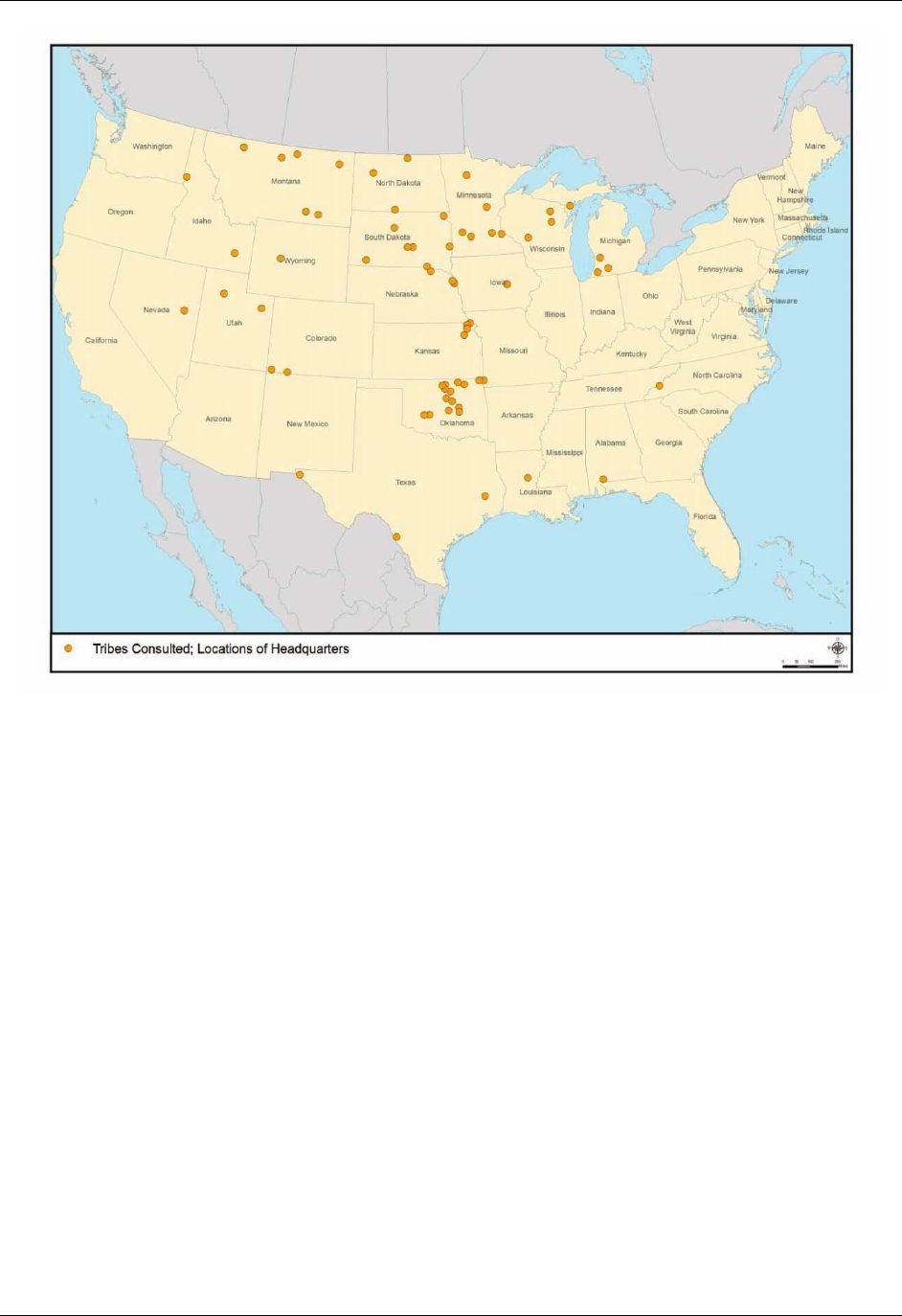
Final Supplemental Environmental Impact Statement Executive Summary
Keystone XL Project
ES-27
Figure ES-13 Indian Tribes Consulted
ES.4.16
Environmental Impacts in Canada
While the proposed Project analyzed in this
Supplemental EIS begins at the international boundary
where the pipeline would exit at Saskatchewan,
Canada, and enter the United States through Montana,
the origination point of the pipeline system would be in
Alberta, Canada. In addition to the environmental
analysis of the proposed Project in the United States,
the Department monitored and obtained information
from the environmental analysis of the Canadian
portion of the proposed Project. The Canadian
government, not the Department, conducted an
environmental review of the portion of the proposed
Project within Canada. However, the Department has
included information from the Canadian government’s
assessment in this Supplemental EIS and has continued
to monitor information from Canada as it becomes
available.
On March 11, 2010, the Canadian National Energy
Board issued its 168-page Reasons for Decision
granting Keystone’s application to build the Canadian
portion of the proposed Project. This document
provided a rationale for the approval of the pipeline by
Canadian regulatory authorities and a description of the
National Energy Board’s analysis of the following
topics: economic feasibility, commercial impacts, tolls
and tariffs, engineering, land matters, public
consultation, aboriginal consultation, and
environmental and socioeconomic matters.
Moreover, analysis and mitigation of environmental
impacts in Canada more generally are ongoing by
Canadian officials. For example, on September 1, 2012,
the Government of Alberta’s development plan for the
Lower Athabascan oil sands region became effective.
The plan requires cancellation of about 10 oil sands
leases, sets aside nearly 20,000 square kilometers
(7,700 square miles) for conservation, and sets new
environmental standards for the region in an effort to
protect sensitive habitat, wildlife, and forest land.

Final Supplemental Environmental Impact Statement Executive Summary
Keystone XL Project
ES-28
ES.5.0 ALTERNATIVES
Detailed analysis was conducted on three broad
categories of alternatives to the proposed Project,
consistent with NEPA:
• No Action Alternative—which addresses potential
market responses that could result if the
Presidential Permit is denied or the proposed
Project is not otherwise implemented;
• Major Route Alternatives—which includes other
potential pipeline routes for transporting WCSB
and Bakken crude oil to Steele City, Nebraska; and
• Other Alternatives—which include minor route
variations, alternative pipeline designs, and
alternative sites for aboveground facilities.
Several alternatives exist for the transport of WCSB
and Bakken crude oil to Gulf Coast refineries, including
many that were not carried forward for detailed
analysis. This Supplemental EIS provides a detailed
description of the categories of alternatives, the
alternative screening process, and the detailed
alternatives identified for further evaluation.
ES.5.1 No Action Alternative
The No Action Alternative analysis considers what
would likely happen if the Presidential Permit is denied
or the proposed Project is not otherwise implemented. It
includes the Status Quo Baseline, which serves as a
benchmark against which other alternatives are
evaluated. Under the Status Quo Baseline, the proposed
Project would not be constructed and the resulting
direct, indirect, and cumulative impacts that are
described in this Supplemental EIS would not occur.
The Status Quo Baseline is a snapshot of the crude oil
production and delivery systems at current levels – in
other words, no change at all – irrespective of likely
alternative transport scenarios to transport WCSB and
Bakken crude.
The No Action Alternative includes analysis of three
alternative transport scenarios that, based on the
findings of the market analysis, are believed to meet the
proposed Project’s purpose (i.e., providing WCSB and
Bakken crude oil to meet refinery demand in the Gulf
Coast area) if the Presidential Permit for the proposed
Project were denied, or if the pipeline were otherwise
not constructed. Under the alternative transport
scenarios, other environmental impacts would occur in
lieu of the proposed Project. This Supplemental EIS
includes analysis of various combinations of
transportation modes for oil, including truck, barge,
tanker, and rail. These scenarios are considered
representative of the crude oil transport alternatives
with which the market would respond in absence of the
Keystone XL pipeline. These three alternative transport
scenarios (i.e., the Rail and Pipeline Scenario, Rail and
Tanker Scenario, and Rail Direct to the Gulf Coast
Scenario) are described below and illustrated on Figure
ES-14.
ES.5.1.1 Rail and Pipeline Scenario
Under this scenario, WCSB and Bakken crude oil (in
the form of dilbit or synbit) would be shipped via rail
from Lloydminster, Saskatchewan (the nearest rail
terminal served by two Class I rail companies), to
Stroud, Oklahoma, where it would be temporarily
stored and then transported via existing and expanded
pipelines approximately 17 miles to Cushing,
Oklahoma, where the crude oil would interconnect with
the interstate oil pipeline system.
This scenario would require the construction of two
new or expanded rail loading terminals in
Lloydminster, Saskatchewan (the possible loading point
for WCSB crude oil), one new terminal in Epping,
North Dakota (the representative loading point for
Bakken crude oil), seven new terminals in Stroud, and
up to 14 unit trains (consisting of approximately
100 cars carrying the same material and destined for the
same delivery location) per day (12 from Lloydminster
and two from Epping) to transport the equivalent
volume of crude oil as would be transported by the
proposed Project.
ES.5.1.2 Rail and Tanker Scenario
The second transportation scenario assumes crude oil
(as dilbit or synbit) would be transported by rail from
Lloydminster to a western Canada port (assumed to be
Prince Rupert, British Columbia), where it would be
loaded onto Suezmax tankers (capable of carrying
approximately 986,000 barrels of WCSB crude oil) for
transport to the U.S. Gulf Coast (Houston and/or Port
Arthur) via the Panama Canal. Bakken crude would be
shipped from Epping to Stroud via BNSF Railway or
Union Pacific rail lines, similar to the method described
under the Rail and Pipeline Scenario. This scenario
would require up to 12 unit trains per day between
Lloydminster and Prince Rupert, and up to two unit
trains per day between Epping and Stroud. This
scenario would require the construction of two new or
expanded rail loading facilities in Lloydminster with
other existing terminals in the area handling the
majority of the WCSB for shipping to Prince Rupert.
Facilities in Prince Rupert would include a new rail
unloading and storage facility and a new marine
terminal encompassing approximately 4,200 acres and
capable of accommodating two Suezmax tankers. For
the Bakken crude portion of this Scenario, one new rail
terminal would be necessary in both Epping, North
Dakota, and Stroud, Nebraska.
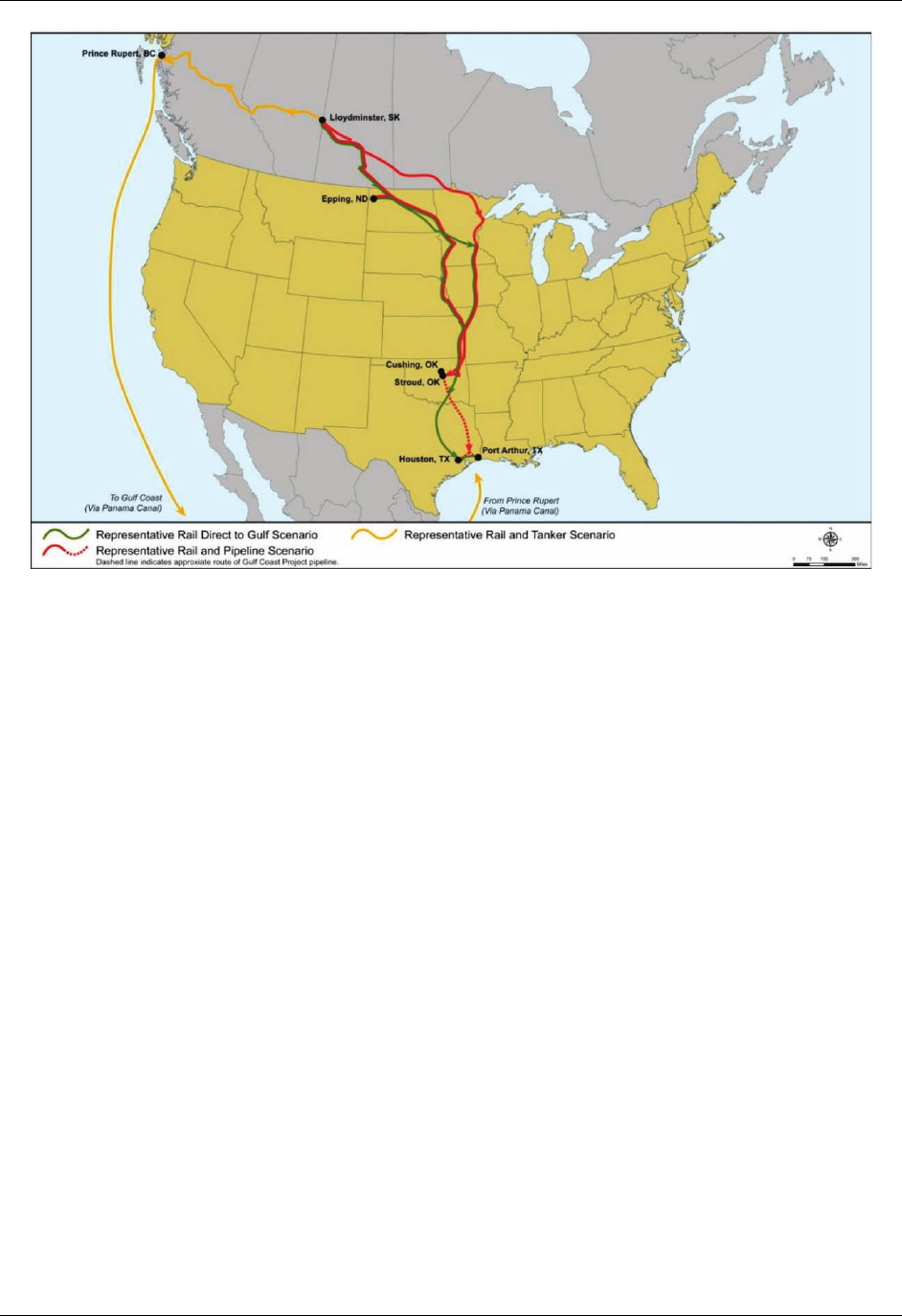
Final Supplemental Environmental Impact Statement Executive Summary
Keystone XL Project
ES-29
Figure ES-14 Representative No Action Alternative Scenarios
ES.5.1.3 Rail Direct to the Gulf Coast
Scenario
The third transportation scenario assumes that WCSB
and Bakken crude oil (as dilbit) would be shipped by
rail from Lloydminster, Saskatchewan, and Epping,
North Dakota, directly to existing rail facilities in the
Gulf Coast region capable of off-loading up to 14 unit
trains per day. These existing facilities would then
either ship the crude oil by pipeline or barge the short
distance to nearby refineries. It would largely rely on
existing rail terminals in Lloydminster, but would likely
require construction of up to two new or expanded
terminals to accommodate the additional WCSB
shipments out of Canada. One new rail loading terminal
would be needed in Epping to ship Bakken crude oil.
Sufficient off-loading rail facilities currently exist or
are proposed in the Gulf Coast area such that no new
terminals would need to be built under this scenario.
ES.5.2 Major Pipeline Route Alternatives
The Department considered potential alternative
pipeline routes to assess whether or not route
alternatives could avoid or reduce impacts to
environmentally sensitive resources while also meeting
the proposed Project’s purpose. Consistent with NEPA,
a two-phase screening process was used to evaluate
prospective alternatives using a set of criteria to
determine their technical, environmental, and economic
viability. Alternatives that failed to meet the screening
criteria were not brought forward for detailed analysis
in this Supplemental EIS. The initial (Phase I)
screening of other major route alternatives considered
the following criteria:
• Meeting the proposed Project’s purpose and need,
including whether the alternative would require
additional infrastructure such as a pipeline to
access Bakken crude oil;
• Availability;
• Reliability;
• Length within the United States;
• Total length of the pipeline, including both the
United States and Canada;
• Estimated number of aboveground facilities;
• Length co-located within an existing corridor;
• Acres of land directly affected during construction;
and
• Acres of land directly affected permanently.

Final Supplemental Environmental Impact Statement Executive Summary
Keystone XL Project
ES-30
Pipeline length was used as an important screening
criterion because it has a relatively direct relationship
with:
• System reliability, in that the longer the pipeline
the greater risk that some portion may become
inoperable at some point, thereby delaying
shipments.
• Environmental impacts, including:
− Risk of spills and leaks, which represent the
greatest potential threat to water and aquatic
resources;
− Temporary construction-related disturbance to
natural habitat (e.g., wetlands, forests, native
prairie); and
− Permanent habitat fragmentation.
• Construction and operational costs, which
generally increase in proportion to overall pipeline
length.
All other factors being equal, longer pipelines are less
desirable because they represent greater risks to system
reliability, environmental impacts, and project costs.
As a result of this Phase I screening process, the
following alternatives were eliminated because they
would not meet the project purpose and/or were
significantly longer than other viable options (see
Figure ES-15):
• Western Alternative (to Cushing);
• Express Platte Alternative; and
• Existing Keystone Corridor
− Option 1: Proposed Border Crossing (near
Morgan, Montana)
− Option 2: Existing Keystone Pipeline Border
Crossing (at Pembina, North Dakota).
Several commenters recommended that the proposed
Project parallel the existing Keystone Pipeline rather
than the proposed route. The Department considered
these comments, but ultimately concluded that the
existing Keystone Pipeline Route was not a reasonable
alternative because it would not meet the proposed
Project’s purpose and need (i.e., would not meet
Keystone’s contractual obligations to transport
100,000 bpd of Bakken crude oil). Further, the existing
Keystone Pipeline Corridor would be longer (taking
into consideration pipeline length in both Canada and
the United States), which represents an increased spill
risk. The 2011 Steele City Segment, the I-90 Corridor,
and the Steele City Segment A1A alternatives,
however, were retained for further screening.
The Phase II screening used a desktop data review of
key environmental and other features (e.g., wetlands
and waterbodies crossed, total acreage affected). After
this Phase II screening, the Steele City Segment A1A
Alternative was eliminated because this route would be
longer with an associated increased risk for spills and
leaks, would cross more miles of principal aquifer and
wetlands, and would require a second major crossing of
the Missouri River, relative to the proposed Project. For
these reasons, the Steele City A1A Alternative would
not offer any offsetting environmental advantages
relative to the proposed Project to warrant further
consideration. However, both the 2011 Steele City
Segment and I-90 Corridor alternatives were considered
reasonable alternatives and were retained for full
evaluation in this Supplemental EIS. These two route
alternatives are described below and depicted in Figure
ES-15. Table ES-4 summarizes key aspects of the
major pipeline route alternatives.
Table ES-4 Summary of Major Pipeline Route Alternatives
Proposed
Project
2011 Steele City
Segment Alternative
I-90 Corridor
Alternative
New Pipeline Length (miles) 875 854 927
Number of Aboveground Facilities
a
73 71 77
Length Co-Located with Existing Keystone Pipeline (miles) 0 0 254
NDEQ-Identified Sand Hills Region Crossed (miles) 0 89 0
Highly Erodible Soil (Wind) Crossed (miles) 73 116 36
Perennial Waterbody Crossings 56 53 61
Wetlands Affected during Construction (acres) 262 544 223
Average Annual Employment During Construction 3,900 3,900 4,100
Property Tax Revenues (millions) $55.6 $53.7 $59.3
Construction Land Area Affected (acres) 11,593 11,387 12,360
Operations (Permanent) Land Area Required (acres) 5,569 5,176 4,818
a
Does not include 2 pump stations for the Cushing Extension in Kansas
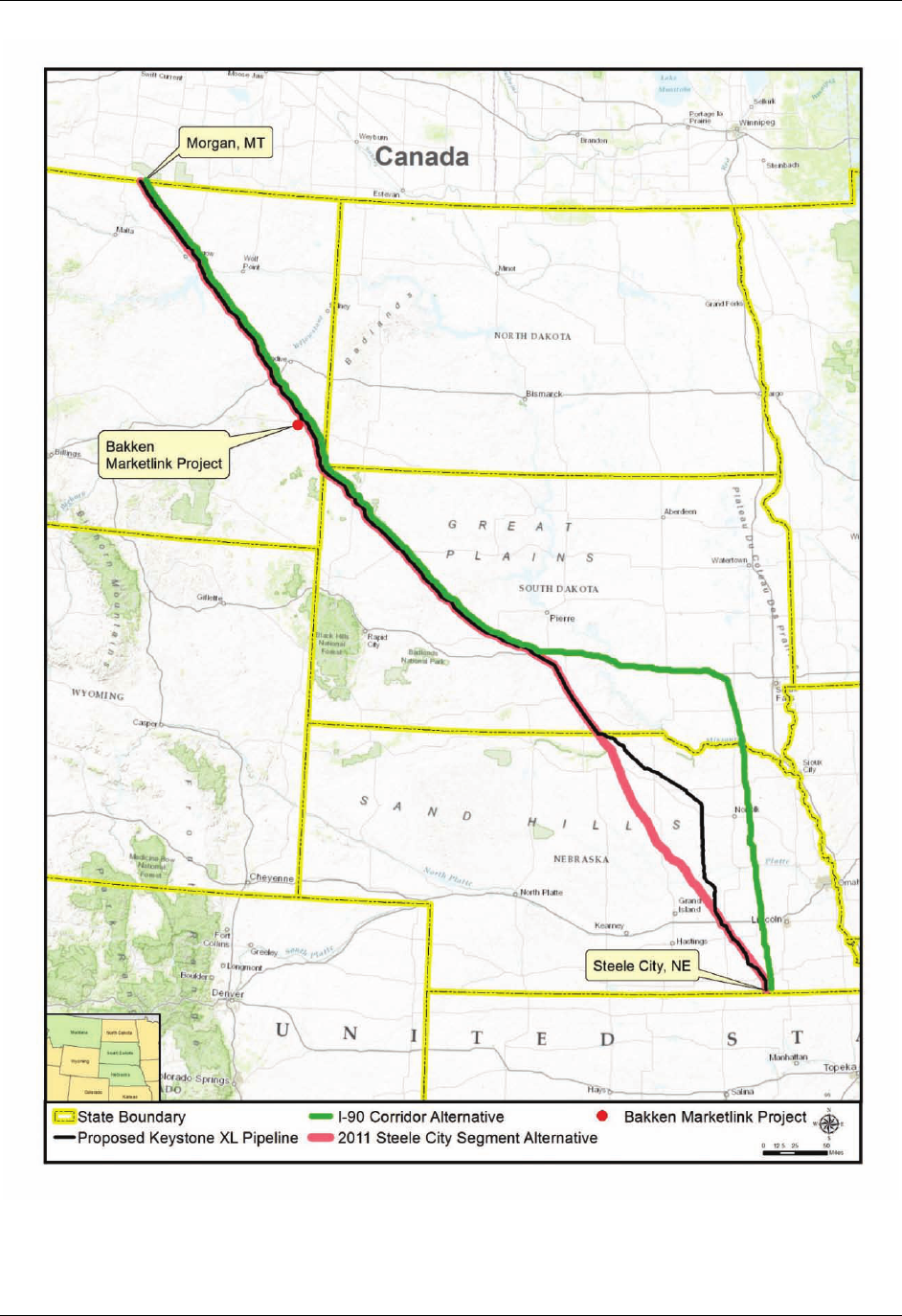
Final Supplemental Environmental Impact Statement Executive Summary
Keystone XL Project
ES-31
Figure ES-15 Preliminary Pipeline Route Alternatives

Final Supplemental Environmental Impact Statement Executive Summary
Keystone XL Project
ES-32
ES.5.2.1 Keystone XL 2011 Steele City
Segment Alternative
The Keystone XL 2011 Steele City Segment
Alternative evaluates the impacts of constructing the
route proposed in the 2011 Final EIS as a comparison
against which other route alternatives, including the
proposed Project, can be made. This alternative would
follow Keystone’s proposed Project route from the
Canadian border, designated Milepost (MP) 0, south to
approximately MP 204, where it would connect with
the Bakken Marketlink Project onramp at the same
location as the proposed Project and continue to
approximately MP 615 in northern Nebraska near the
South Dakota state line. At that location, the Keystone
XL 2011 Steele City Segment Alternative would divert
from the current proposed Project and would continue
southeasterly for another 240 miles to the southern
terminus at Steele City, Nebraska. For approximately
89 miles, the Keystone XL 2011 Steele City Segment
Alternative would cross the NDEQ-identified Sand
Hills Region.
ES.5.2.2 I-90 Corridor Alternative
Keystone’s proposed Project route starts at the
Canadian Border (MP 0) and stretches south through
Montana and into South Dakota to approximately MP
516, where the proposed pipeline route intersects
Interstate 90 (I-90). From this point, this alternative
pipeline route would diverge from the proposed Project
route, following the ROW of I-90 and State Highway
262 for 157 miles, where it would then intersect and
follow the ROW of the existing Keystone pipeline to
Steele City, Nebraska.
The I-90 Corridor would avoid crossing the NDEQ-
identified Sand Hills Region, and would reduce the
length of pipeline crossing the NHPAQ system, which
includes the Ogallala Aquifer.
ES.5.3 Other Alternatives Considered
In addition to the major route alternatives, the
Department reviewed proposed variations—relatively
short deviations—to the proposed route that were
designed to avoid or minimize construction impacts to
specific resources (e.g., cultural resource sites,
wetlands, recreational lands, residences) or that
minimize constructability issues (e.g., shallow bedrock,
difficult waterbody crossings, steep terrain).
The Department also considered two alternative
pipeline designs in response to public comments: an
aboveground pipeline and an alternative using a
smaller-diameter pipe. The Department determined that
both alternative designs were not reasonable
alternatives for the proposed Project because they
would not meet the proposed Project purpose and need
and/or because of safety and security reasons; therefore,
they were not considered further in this
Supplemental EIS.
This Supplemental EIS considered renewable energy
sources and energy conservation as alternatives to the
proposed Project. As noted in Section 1.4, Market
Analysis, the crude oil would be used largely for
transportation fuels and, therefore, any alternatives to
the crude oil would need to fulfill the same purpose.
The analysis found that even with renewable energy
and conservation, there would still be a demand for oil
sands-derived crude oil. Based on this evaluation, these
alternatives were not carried forward for further
analysis as alternatives to the proposed Project.
ES.5.4 Comparison of Alternatives
Consistent with NEPA and the CEQ regulations, the
Department compared the proposed Project with the
alternatives that met the proposed Project’s purpose and
need, and that were carried forward for detailed
analysis in this Supplemental EIS. The alternatives
carried forward for detailed analysis were: the 2011
Steele City Segment Alternative, the I-90 Corridor
Alternative, and the three identified No Action
Alternative scenarios (i.e., the Rail and Pipeline
Scenario, the Rail and Tanker Scenario, and the Rail
Direct to the Gulf Coast Scenario).
The two pipeline alternatives compare different routes
that meet the purpose and need of the proposed Project,
and the No Action Alternative scenarios describe the
likely potential impacts associated with transport of
crude oil from the WCSB and the Bakken formations if
the Presidential Permit is denied or if the proposed
Project is not otherwise implemented. The comparison
focuses on three categories of impacts: physical
disturbance, GHG emissions, and potential releases.
ES.5.4.1 Physical Disturbance Impacts
Alternatives Comparison
The primary differences between the proposed Project
and the alternatives related to physical disturbance are
summarized in Table ES-5.

Final Supplemental Environmental Impact Statement Executive Summary
Keystone XL Project
ES-33
Table ES-5 Physical Disturbance Impacts Associated with New Construction and Operations for the Proposed Project and Alternatives
Status Quo
Baseline
Proposed
Project
2011 Steele City
Segment
Alternative
I-90
Corridor
Alternative
No Action
Rail/Pipeline
Scenario
No Action
Rail/Tanker
Scenario
No Action
Rail Direct
to the Gulf
Coast
Scenario
New Pipeline Length (miles) 0 875 854 927 17 32 0
Number of New Aboveground Facilities 0 73 71 77 33 33 19
Length Co-located with Existing Keystone
Pipeline (miles) 0 0 0 254 NA NA NA
NDEQ-Identified Sand Hills Region Crossed
(miles) 0 0 89 0 0 0 0
New Highly Erodible Soil (Wind) Crossed
(miles) 0 73 116 36 0 0 0
Perennial Waterbody Crossings 0 56 53 61 1,216 330 711
Major Water Crossings
a
0 62 60 61 42 14 40
Number of Shallow Wells in Proximity
b
0 113 97 42 NA NA NA
New NHPAQ Crossed (miles) 0 294 247 145 NA NA NA
Wetland Affected during Construction (acres) 0 262 544 223 193 351 NQ
c
Communities within 2 Miles 0 17 16 37 350 182 669
Construction (Temporary) Land Area Affected
(acres) 0 11,599 11,387 12,360 5,227 6,427 1,500
Operations (Permanent) Land Area Required
(acres) 0 5,309 5,176 4,818 5,103 6,303 1,500
Notes: This table does not include Canadian impacts for pipeline alternatives.
NA = not applicable
NQ = not quantified; insufficient design data
NDEQ = Nebraska Department of Environmental Quality
NHPAQ = Northern High Plains Aquifer
a
This is defined as channel crossings of waterbodies that delineate U.S. Geological Survey National Hydrography Dataset Level 4 (HUC4) Hydrologic Unit watershed basins.
b
A shallow well is defined as a well with a depth of 50 feet or less, but does not include wells with zero depth; proximity is defined as within ¼ mile of the centerline.
c
Specific facility footprints for this scenario are not known at this time. However, impacts would be generally similar to the other rail scenarios.

Final Supplemental Environmental Impact Statement Executive Summary
Keystone XL Project
ES-34
ES.5.4.2 Greenhouse Gas Emissions
Alternatives Comparison
To facilitate comparison of GHG emissions across all
alternatives for operational GHG emissions, an
assessment was made for all alternatives along the
entire route from Hardisty, Alberta, to the Gulf Coast
(including pipelines in Canada and from Steele City to
the Gulf Coast). GHG emissions from the two pipeline
route alternatives would be similar in scale to those of
the proposed Project. The direct emissions during the
operation phase of the 2011 Steele City Segment
Alternative would be essentially the same as those
generated by the proposed Project because they would
have the same number of pump stations (20). The I-90
Corridor Alternative is expected to have similar but
slightly higher GHG emissions because it would have
one more pump station than the proposed Project and
could generate slightly higher amounts of indirect GHG
emissions from electricity consumption.
During operation of all No Action rail scenarios, the
increased number of unit trains along the scenario
routes would result in GHG emissions from both diesel
fuel combustion and electricity generation to support
rail terminal operations (as well as for pump station
operations for the Rail/Pipeline Scenario). The total
annual GHG emissions (direct and indirect) attributed
to the No Action scenarios range from 28 to 42 percent
greater than for the proposed Project (see Table ES-6).
The indirect GHG emissions over the lifecycle of oil
sands crude oil production, transportation, refining, and
product use are compared between the proposed Project
and the evaluated alternatives in Section ES.4.1.2,
Lifecycle Analysis.
Table ES-6 Annual Greenhouse Gas Emissions from Crude Transport (from Hardisty/Lloydminster,
Alberta, to the Gulf Coast Area) Associated with the Proposed Project and Alternatives
(per 100,000 bpd)
Overall
Proposed
Project
Route
a
Overall 2011
Steele City
Segment
Alternative
Route
b
Overall I-90
Corridor
Alternative Route
c
No Action
Rail/Pipeline
Scenario
No Action
Rail/Tanker
Scenario
No
Action
Rail
Direct to
the Gulf
Coast
Scenario
Operation (direct and indirect)—Transportation, Not Extraction
MTCO
2
e/Year
per 830,000 bpd 3,123,859 3,123,844 3,211,946 4,428,902 4,364,611 3,991,472
MTCO
2
e/Year
per 100,000 bpd 376,369 376,367 386,981 533,603 525,857 480,900
% Difference
from Proposed
Project NA 0.0% 2.8% 41.8% 39.7% 27.8%
a
Canadian, Proposed Project, and Gulf Coast
b
Canadian, Steele City Segment, and Gulf Coast
c
Canadian, I-90, and Gulf Coast
Notes: The emissions shown for the overall proposed Project differ from those shown for the proposed Project in Section
ES.4.1.1, Greenhouse Gas Emissions from the Proposed Project, in order to present a full comparison of the overall proposed
Project route to the other alternatives. All data include train emissions for return trips as well.
MTCO
2
e = metric tons of CO
2
equivalents
NA = not applicable
bpd = barrels per day

Final Supplemental Environmental Impact Statement Executive Summary
Keystone XL Project
ES-35
ES.5.4.3 Potential Spill Risk Alternatives
Comparison
Similar to the GHG emissions comparison, potential
spill risk was evaluated for alternatives along the entire
route from Hardisty, Alberta, to the Gulf Coast
(including portions of the route in Canada and including
existing pipelines from Steele City to the Gulf Coast).
Table ES-7 provides a summary of calculated potential
release impacts for the various alternatives analyzed in
terms of the number of potential releases per year and
the potential volume of oil released per year.
Both of the major route alternatives would begin at the
same border crossing as the proposed Project (near
Morgan, Montana) and end at the same location as the
proposed Project (near Steele City, Nebraska); as such,
the pipelines in Canada north of the border crossing and
the pipelines south of Steele City down to the Gulf
Coast would be identical for all three overall pipeline
routes. Compared to the proposed Project, the two
major pipeline route alternatives would have similar
potential spill risks (see Table ES-7). In addition, both
of these major route alternatives would require
aboveground facilities that are similar to those for the
proposed Project; therefore, potential releases impact
areas would be similar. Because the I-90 Corridor
Alternative is slightly longer than the proposed Project,
it would carry a slightly higher spill risk (with an
estimated 533 bbl released per year compared to 518
annual bbl released for the proposed Project).
The three No Action Alternative scenarios differ from
the proposed Project in that they would use alternative
modes of transportation to deliver crude oil to refinery
markets in the Gulf Coast rather than just a pipeline
(although one of the three scenarios includes a pipeline
as a significant part of its delivery system). Potential
spill risks for these alternative modes differ from the
proposed Project in terms of both average spill
frequency and average spill size.
Volume of crude oil transportation by rail in the No
Action Alternative scenarios would generally be limited
to the volume contained within individual railcars. This
volume constrains the total volume of crude oil that
could potentially impact groundwater relative to the
proposed Project in the event of a release. This
constraint is offset by the increased statistical likelihood
of spills associated with these alternative modes of
crude oil transport relative to pipelines.
Historical rail incident data were analyzed to evaluate
potential releases associated with rail transport in the
United States. The results help provide insight into
what could potentially occur with respect to spill
volume, incident cause, and incident frequency for the
No Action Alternative scenarios that involve rail
transport. In addition, rail incident frequencies were
compared to frequencies for other modes of transport
(i.e., pipeline, marine tanker). Although the product to
be transported by the proposed Project is crude oil,
incidents for petroleum products were also analyzed to
provide a comparison to a larger dataset. In order to
make comparisons between the modes of
transportation, the statistics regarding releases are
expressed in terms of ton-miles (1 ton-mile is
transporting 1 ton of product 1 mile; to calculate total
ton-miles in a given year, one multiplies the total tons
transported by the total number of miles transported).
The rates of releases and average size of releases vary
between modes of transportation. For instance, rail
transport has more reported releases of crude oil per
ton-mile than pipeline or marine transport but, overall,
pipeline transport has the highest number of barrels
released per ton-mile. Comprehensive data from 2010
to 2013 are not yet available and therefore this analysis
does not include incidents subsequent to 2009 such as
the 2013 Lac-Mégantic rail tragedy or the Tesoro
Logistics pipeline incident. The number of barrels
released per year for the No Action scenarios is higher
than what is projected for the proposed Project or the
other pipeline alternatives (as detailed in Table ES-7)
because of the alternate modes of transport in the No
Action scenarios.
There is also a greater potential for injuries and
fatalities associated with rail transport relative to
pipelines. Adding 830,000 bpd to the yearly transport
mode volume would result in an estimated 49 additional
injuries and six additional fatalities for the No Action
rail scenarios compared to one additional injury and no
fatalities for the proposed Project on an annual basis.

Final Supplemental Environmental Impact Statement Executive Summary
Keystone XL Project
ES-36
Table ES-7 Potential Releases Impacts (Full Pathway) Associated with the Proposed Project and Alternatives
Overall
Proposed Project
Route
a
Overall 2011
Steele City
Segment
Alternative
Route
b
Overall I-90
Corridor
Alternative
Route
c
No Action
Rail/Pipeline
Scenario
No Action
Rail/Tanker
Scenario
No Action Rail Direct
to the Gulf Coast
Scenario
Option 1
g
Option 2
g
Miles for Transport
(Overall Route) 1,938 1,917 1,990 3,902 14,014 4,624 5,375
Releases per
Year
d,e
0.46 0.46 0.48 294 276 383 455
Barrels Released
per Year
f
518 513 533 1,227 4,633 1,335 1,606
a
Canadian, Proposed Project, and Gulf Coast
b
Canadian, Steele City Segment, and Gulf Coast
c
Canadian, I-90, and Gulf Coast
d
Releases per year frequency was calculated using databases from the U.S. Department of Transportation covering U.S. transportation in the years 2002 to 2009. The pipeline spill
frequency was based on a 16-inch diameter crude oil pipeline.
e
Releases per Year = (16-inch U.S. crude pipeline spill frequency * total pipeline ton-miles) + (U.S. rail spill frequency * total rail ton-miles) + (U.S. marine spill frequency * total
rail ton-miles) + (U.S. truck spill frequency * total truck ton-miles).
f
Barrels Released per Year = (average 16-inch U.S. crude pipeline barrels (bbl) released * total pipeline ton-miles) + (average rail bbl released * total rail ton-miles) + (average
marine bbl) released * total rail ton-miles) + (average truck bbl released * total truck ton-miles).
g
The Option 1 route goes through Lloydminster while Option 2 routes through Fort McMurray.

Final Supplemental Environmental Impact Statement Executive Summary
Keystone XL Project
ES-37
ES.6.0 GUIDE TO READING THE SUPPLEMENTAL EIS
The Supplemental EIS consists of 11 volumes and is
available electronically for viewing or download at
www.keystonepipeline-xl.state.gov. Various sections of
this document contain bibliographies with full lists of
references and citations. A list of where to find printed
copies of the complete Supplemental EIS can be found
at www.keystonepipeline-xl.state.gov or by mail
inquiry to:
U.S. Department of State
Attn: Mary Hassell, NEPA Coordinator
2201 C Street NW
Room 2726
Washington D.C. 20520
ES.7.0 SUPPLEMENTAL EIS
CONTENTS
The location of information within this Supplemental
EIS is provided below.
Chapter 1: Introduction
1.1: Background
1.2: Overview of Proposed Project
1.3: Purpose and Need
1.4: Market Analysis
1.5: Agency Participation
1.6: Tribal and SHPO Consultation
1.7: Environmental Review of the Canadian
Portion of the Keystone XL Project
1.8: Preparation of Publication
1.9: Permits, Approvals, and Regulatory
Requirements
Chapter 2: Description of the Proposed Project and
Alternatives
2.1: Overview of the Proposed Project
2.2: Description of Alternatives
Chapter 3: Affected Environment
3.1: Geology
3.2: Soils
3.3: Water Resources
3.4: Wetlands
3.5: Terrestrial Vegetation
3.6: Wildlife
3.7: Fisheries
3.8: Threatened and Endangered Species and
Species of Conservation Concern
3.9: Land Use, Recreation, and Visual Resources
3.10: Socioeconomics
3.11: Cultural Resources
3.12: Air Quality and Noise
3.13: Potential Releases
Chapter 4: Environmental Consequences
4.1: Geology
4.2: Soils
4.3: Water Resources
4.4: Wetlands
4.5: Terrestrial Vegetation
4.6: Wildlife
4.7: Fisheries
4.8: Threatened and Endangered Species and
Species of Conservation Concern
4.9: Land Use, Recreation, and Visual Resources
4.10: Socioeconomics
4.11: Cultural Resources
4.12: Air Quality and Noise
4.13: Potential Releases
4.14: Greenhouse Gases and Climate Change
4.15: Cumulative Effects Assessment
4.16: Summary of Impacts
Chapter 5: Alternatives
5.1: No Action Alternative
5.2: Route Alternatives
5.3: Comparison of Alternatives
Chapter 6: List of Preparers
Chapter 7: Distribution List—Supplemental EIS or
Executive Summary
Chapter 8: Index

Final Supplemental Environmental Impact Statement Executive Summary
Keystone XL Project
ES-38
Appendices
A: Governor Approval of the Keystone XL
Project in Nebraska
B: PHMSA Special Conditions and Mitigation
Measures
C: Supplemental Information to Market Analysis
D: Waterbody Crossing Tables and Required
Crossing Criteria for Reclamation Facilities
E: Record of Consultation
F: Scoping Summary Report
G: Construction, Mitigation, and Reclamation
Plan (CMRP)
H: 2012 Biological Assessment, 2013 USFWS
Biological Opinion, and Associated
Documents
I: Spill Prevention, Control, and Countermeasure
Plan; and Emergency Response Plan Sections
J: Basin Electric Big Bend to Witten 230-kV
Transmission Project Routing Report
K: Historical Pipeline Incident Analysis
L: Oil and Gas Wells within 1,320 ft of Proposed
Right-of-Way
M: Soil Summary for Montana, South Dakota, and
Nebraska
N: Supplemental Information for Compliance
with Montana Environmental Policy Act
O: Socioeconomics
P: Risk Assessments
Q: Crude Oil Material Safety Data Sheets
R: Construction/Reclamation Plans and
Documentation
S: Pipeline Temperature Effects Study
T: Screening Level Oil Spill Modeling
U: Lifecycle Greenhouse Gas Emissions of
Petroleum Products from WCSB Oil Sands
Crudes Compared with Reference Crudes
V: Literature Review
W: Past, Present, and Reasonably Foreseeable
Future Project Descriptions
X: Canadian Environmental Assessment Act and
Canadian Regulatory Review of Keystone XL
Y: Estimated Criteria Pollutants, Noise, and GHG
Emissions
Z: Compiled Mitigation Measures
